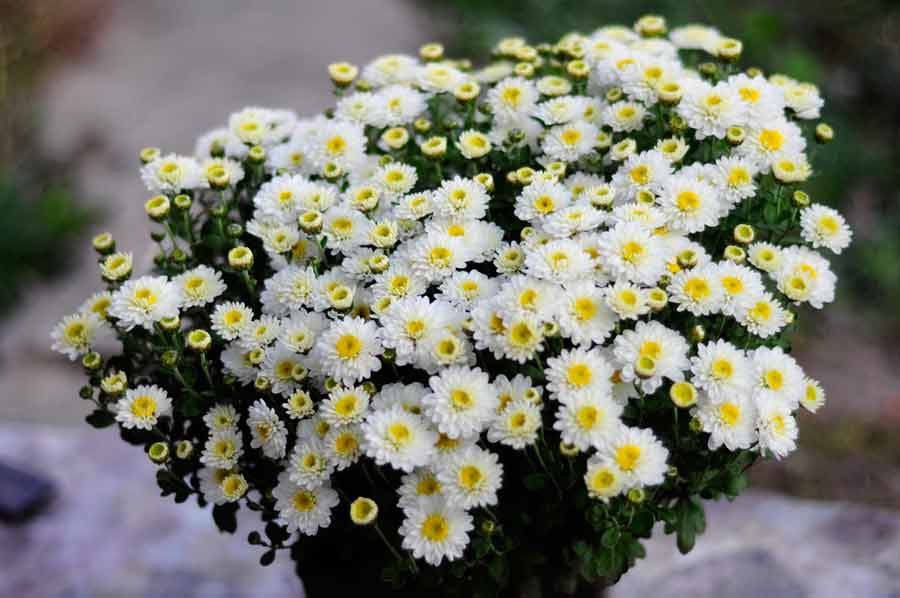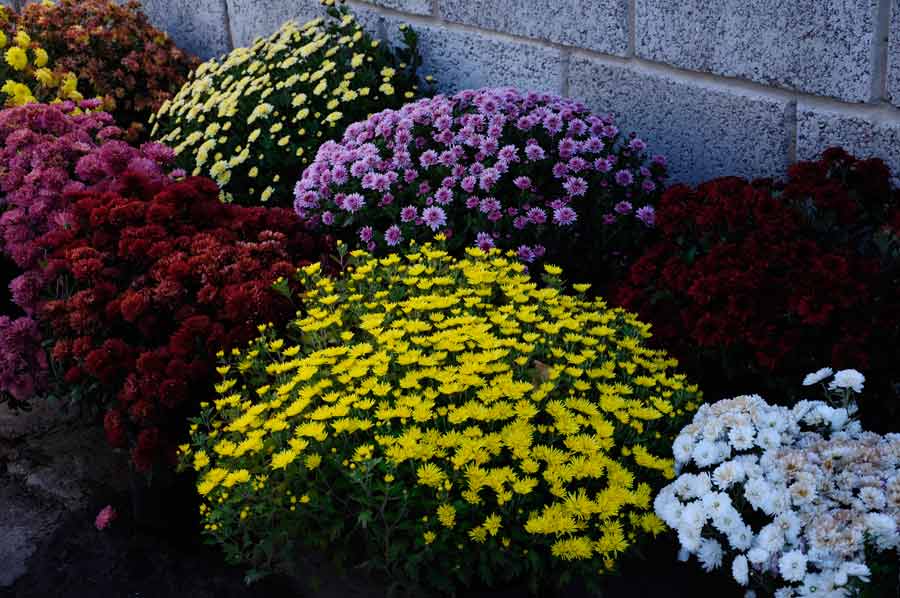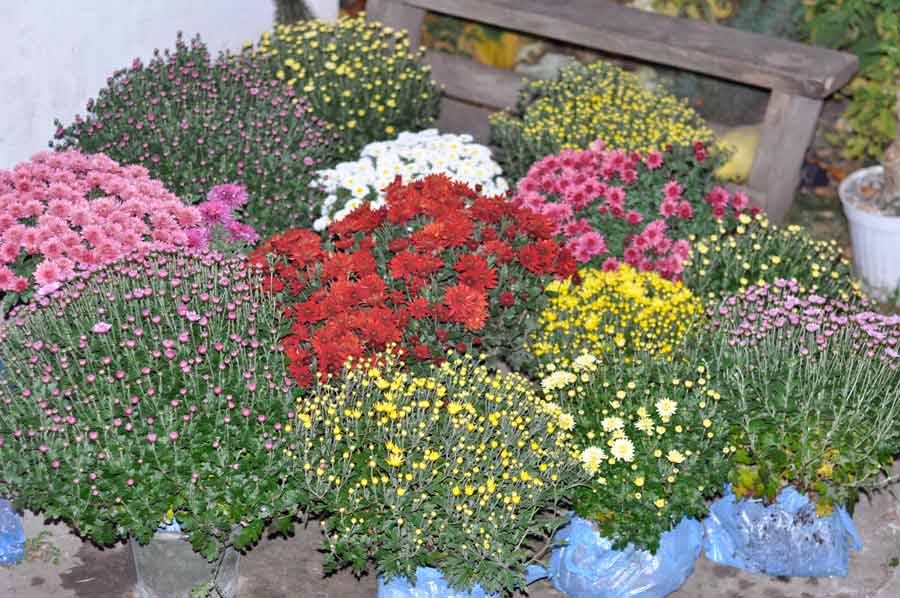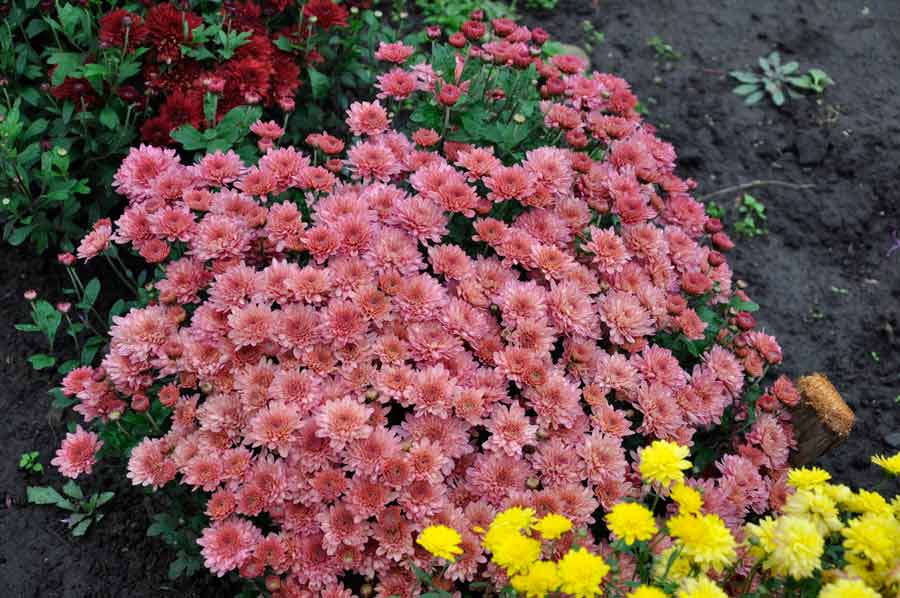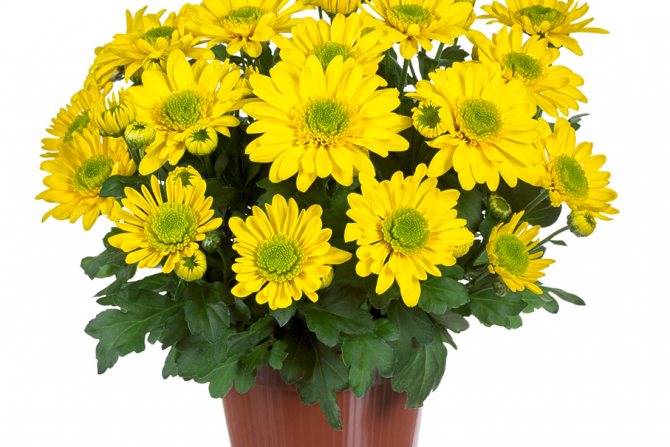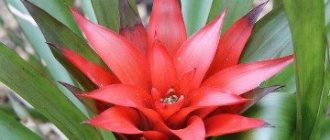From the article you will find out what a spherical chrysanthemum flower looks like, photos of the plant are given in the section at the bottom of the article. A detailed description tells about the varieties and varieties of flowers. With the help of the review, you will receive information on how to choose the chrysanthemum you need in terms of flowering time. Fully familiarize yourself with planting, reproduction and caring for the plant, you can protect the flower from diseases and pests. Use the acquired knowledge, grow a magnificent ball-shaped chrysanthemum in your apartment or at home.
Chrysanthemum pruning
The stems are cut after the onset of cold weather. Chrysanthemum tolerates light frosts well, sometimes the snow falls on the lush flowering bushes. But you cannot leave the bushes uncut in the winter.
Despite the treatment with fungicides and insecticides, parasites can lurk in the aerial part of the plant.
With the onset of cold weather, we examine the bush from all sides and remove dried shoots. Cut the flower stems with pruning shears at a height of 12-15 cm from the ground. The tops are burned or composted.

Cut healthy, strong stems at a height of 10-14 cm. Leave the young growth untouched.


Autumn pruning and fertilization
In late summer - early autumn (August-September), complex fertilizers containing potassium (less) and phosphorus (more) are applied under each chrysanthemum bush. These elements are necessary for flowers in order for their root system to accumulate the nutrients it needs for normal wintering.
Pruning chrysanthemums in autumn is a necessary procedure that makes it easier for flower growers to shelter for the winter those varieties that winter outdoors. And those flowers that are removed to the basement for the winter should also be cut off - this way they are easier to store, long stems can be accidentally broken off.
Chrysanthemum stems are pruned immediately after the onset of the first autumn cold weather. In this case, the length of the cut shoots should not exceed 14-15 cm.
Watering and fertilizing the soil
The preparation of chrysanthemums for winter begins with the introduction of fertilizers under the still flowering bushes (they fertilize the flower 35-40 days before the cold weather sets in, so that the horse system has time to fully absorb the nutrients). Mixtures with a predominance of phosphorus and potassium are used. These substances, accumulating in the roots, contribute to a good wintering of the plant.
They use ready-made mixtures for autumn feeding of chrysanthemums as fertilizers, applying them under each bush according to the instructions, or apply them to 1 square meter. m of soil area:
- 40 g superphosphate;
- 30 g of potassium salt or potassium sulfate.
Instead of mineral fertilizers, you can use wood ash (100 g per 1 sq. M) and bone meal in the same dose.


Fertilizers are applied to moistened soil, evenly scattering over the surface of the earth, then shallow loosening. With subsequent watering, fertilizers will penetrate deep into the soil.
They will increase the vitality of the flower and keep it looking healthy.
A flowering plant is demanding on the presence of moisture in the soil. As a rule, the moisture from the autumn rains is sufficient for the chrysanthemum. But if the autumn turned out to be dry, the flower garden must be watered once a week, spending up to 7 liters of water per bush.
The stream of water is directed under the root of the plant, without soaking the stems and leaves. This will help prevent the development of fungal diseases.
Application
In medicine
From dried flowers of chrysanthemums, tea is brewed, which has the following effect on the body:
- lowers blood pressure by dilating blood arteries;
- regulates the work of the heart muscle;
- has an antibacterial effect, helps with shortness of breath;
- removes toxins from the body, helping to cleanse it;
- soothes with nervous excitement;
- improves hearing, vision.
At home


The plant is used to decorate rooms and gardens, create ekibana from dried flowers, other crafts, make fragrant sachets.
In cosmetology
For cosmetic care of the skin of the face and body, both water tinctures and extracts of chrysanthemum flowers and oil essences are used. Cosmetic baths, wraps, masks, rubbing are made with chrysanthemum essential oil.
Treatment against pests and diseases
10-12 days after the autumn fertilization, it's time to treat the flowers from pests and pathogens. Chrysanthemums are susceptible to fusarium, rust, and other fungal diseases, as well as aphids and spider mites parasitize them.
On a quiet and warm day, the plants are abundantly sprayed:
- Bordeaux mixture (you can buy a ready-made composition in a garden store);
- foundation (20 g per 10 liters of water).
For aphids and spider mites, insecticides (Aktellik, Inta Vir), karbofos, makhorka (100 g per 1 liter of water) are used.
Nutritional value and chemical composition


- The calorie content of dried inflorescences is 24 kcal / 100 g.
- The raw materials include: flavonoids, organic acids, carotenoids, a wide range of vitamins, unsaturated aromatic unsaturated lactones, organic acids, amino acids, sugars, pectins, macro- and microelements, anthocyanins, glycosidic compounds, aromatic essential oils, hydrocarbons.
Chrysanthemum shelter for the winter
All varieties and varieties of chrysanthemums are divided into two groups:
- wintering in the open field,
- requiring storage at freezing temperatures in the room.


Large-flowered perennial chrysanthemums, which are grown for cutting, do not overwinter in the soil in the Russian climate. Spherical varieties of chrysanthemums and a type of flower, multiflora, require digging.
Small-flowered or Korean and bush chrysanthemums overwinter in the ground under cover. They are also called "oaks". In the south of Russia (Krasnodar and Stavropol Territories, Astrakhan), these chrysanthemums do not require shelter for the winter. In other regions, plants must be insulated for a safe wintering.
They begin to shelter chrysanthemums when the air temperature drops to zero in the daytime.
In the suburbs and the Middle Lane, the right time comes in October. In the Leningrad region 10 days earlier.
In the Urals and Siberia, even unpretentious "oaks" do not always survive in the soil. If frosts hit before the ground is covered with a layer of snow, no shelter will save the flowers. Experienced gardeners recommend not to risk it and dig up all the chrysanthemums at the end of September and put them away for storage.
In the southern regions of our country, it is not necessary to shelter Korean chrysanthemums (oaks). Large-flowered varieties and multiflora are insulated at the end of October - November.
For insulating bushes, they are used:
- large wood chips;
- peat;
- fallen leaves;
- agrotechnical fabric.
The success of wintering chrysanthemums in the soil depends not only on the quality of the shelter and the climate of the region, but also on the place of planting the flower on the site. Chrysanthemums planted near buildings, from the sunny side, in places protected from the wind, winter more successfully than bushes planted in open beds.
We huddle the bush and make a small mound of the ground.


After the temperature has dropped below -5 degrees, cover the top with a special material. To prevent it from being blown away by the wind, sprinkle the lower edge of the fabric with earth.


You can cover it in another way.We make mulch from spruce or pine branches in the form of a house. Snow will linger on them well, and the plant will perfectly tolerate winter frosts.


In the spring, the shelter is removed as soon as the snow melts, preventing the plant from heating up.
Video: wintering chrysanthemums in the Middle lane
Information about the preparation of chrysanthemums for winter in the Moscow region and the Middle zone from the Sadovy Mir canal.
Pruning winter-hardy varieties
For the regions of the middle and central lane, breeders have bred a group of Korean small-flowered chrysanthemums, which includes many winter-hardy varieties. The most popular florists are the following varieties and hybrids:
- Malchish-Kibalchish;
- Everest;
- Red Moscow;
- Oak;
- Chamomile;
- Purple Haze;
- Korean.
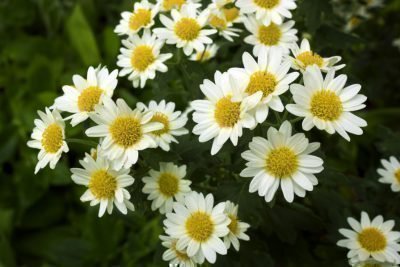

The name of this species comes from a strong similarity with daisies.
Outdoor storage
The wintering of bushes in a cellar or basement is not always successful, since in such rooms it is rarely possible to provide the bushes with good ventilation and a proper temperature regime within 1-3 ° C. Therefore, many growers practice storing bushes in trenches.
Plants are trimmed, fertilized, dug out before the onset of frost. On the site, trenches with a depth of at least 0.5 m are dug, bushes are laid in them, covered with slate and sprinkled with a thick layer of earth.
The shelter is removed immediately when the spring warmth comes. If this time is missed, the plants may start growing earlier.
Chrysanthemum digging and storage
They begin to extract the chrysanthemum bush from the soil when the temperature does not rise above 0. The bush is dug out with a pitchfork, retreating 15 cm from the stems.
It is necessary to extract the plant without destroying the earthen lump with roots.
The chrysanthemum is placed in a suitable sized pot, bucket or box (cardboard can be used). If a lump of earth has crumbled, the earth is poured into the container and the soil is slightly moistened so that the soil fills all the voids and the roots do not dry out.
Store in a basement or cellar at a temperature of about +5 degrees. During storage, the soil in the container must be moistened no more than 1-2 times a month.
In April, pots with chrysanthemums are taken out into a warm and bright room - a room or a greenhouse, watering is resumed. Soon the bush will release the first greens. With the onset of warm weather, the bushes are transplanted into a flower garden.
Video: how to keep spherical chrysanthemums without digging out
Chrysanthemum - care in the fall and preparation for winter
Chrysanthemums are considered one of the most beautiful autumn garden flowers, because they begin their flowering when most of the flowers in the flower beds have already faded (or have finished blooming).
And some growers are convinced that caring for these cultivated plants is not needed either in summer or in autumn. It is necessary to understand - is it really so?
It turns out that some chrysanthemums need care in the fall and some preparation for winter. So, they need to be dug up for the winter and stored in a basement or other cool and dark room. But there are varieties of these flowering perennials that can winter well in the open field with appropriate preparation.
Autumn transplant of perennial chrysanthemums
Autumn planting of Korean chrysanthemums is possible only in the southern regions of our country and in the middle lane. The plant, even in a flowering state, tolerates transplantation well. But it is advisable to choose seedlings with a closed root system.
Read also How to cook corn on the cob
A good landing time is from late August to mid-September. The chrysanthemum planted during these periods will have time to take root and, with reliable insulation, will successfully survive the winter.
For the plant, sunny areas are chosen, with loamy fertile soil. The distance between the bushes is left based on the height of the plants. Low-growing varieties are placed after 25-30 cm, tall ones after 40 cm.
The chrysanthemum is carefully removed from the pot and placed in the planting pit without deepening the plant.After planting, the flower is watered abundantly.
There is nothing difficult in caring for chrysanthemums in the fall, preparing for winter. If everything is done correctly, the flower will easily endure frosts and will delight the next year with exuberant flowering and juicy colors.
Growing and caring for a spherical chrysanthemum brings only pleasure to the grower. The bush blooms early and keeps the buds in a state of dissolution for a long time. The plant is unpretentious and even without scrupulous pruning, the bush always turns out to be lush and uniform. Low-growing chrysanthemum is responsive to fertilizing, regular fertilization ensures lush flowering in the season.
Features of care in the fall and preparation for winter
Chrysanthemums are prepared for winter in different regions at different times, starting around the end of summer, August. Usually, caring for these flowers consists of pruning them, applying fertilizers and preparing them for winter. Different types of these flowers require their own approach to wintering:
- some varieties should be dug up and stored in a dark, cool and dry place;
- while other chrysanthemums hibernate in the open field without digging up.
It is worth talking in more detail about the conduct of each of these agrotechnical measures.
Video: caring for chrysanthemums in the fall and preparing for winter
Plant benefits
Plant varieties differ not only in color, in the duration and frequency of flowering. Florists distinguish between undersized, tall and medium-sized bushes. Low-growing varieties reach a height of no more than 20 cm, medium-sized ones - up to 40, and tall ones - about 70 cm.
Low-growing varieties are used to tame small flower beds, flowerpots for loggias and balconies. They can be easily grown indoors in a regular flower pot. Medium and tall varieties are used for landscaping summer cottages.
Gardeners appreciate multiflora for its unpretentiousness and ease of care and maintenance. The plant combines well with other species, therefore it always fits well into the landscape of the site. Equally valuable is the variety of colors - this allows the owner to create gradients by planting plants in a flower bed in a specific sequence. Low-growing varieties can be used for alpine slides, while tall ones can be used to create a lush, green fence. Planting plants is an opportunity to feel like a designer, because there is a huge field for imagination, and its implementation.
Globular trees
Looks very good on field maple varieties, Acer campestre "Rozi" and "Nanum". Its leaves are smaller than the leaves of Norway maple, with soft outlines. Yellow-red in spring, dark green in summer, bright yellow in autumn.
High-quality maples form a spherical or ovoid crown without any special pruning. Such an Acer campestre "Elsrijk". A mature tree reaches a height of 3.5 - 5 meters and a width of about 2 meters. This maple is very resistant to drought and frost.
It tolerates slight shading, although light-loving. And it feels great in alley and group plantings, it also lends itself very well to topiary haircuts. From non-standard, that is, bush forms, amazing hedges are obtained. This maple is an excellent backdrop for flowering ornamental shrubs and flowers.
Acer platanoides “Globosum” variety of Norway maple is suitable for larger areas and for large alleys. This is also a globular maple. In spring, its leaves are bronze, in summer they are dark green, in autumn they are painted in yellow-orange tones. The tree is very stable, grows on any fertile soil, withstands frost and wind, and is durable. But he doesn't like flooding. Sanitary pruning may sometimes be necessary in early spring.
Features of growing spherical chrysanthemums


Varieties of various sizes are used for growing in a garden plot, but when growing in a private house or apartment, it is better to choose undersized, dwarf varieties.It is quite difficult to grow a tall chrysanthemum at home, because its root system requires space and significant amounts of land mass, which are difficult to provide.
Spherical multiflora is undemanding to care for during the entire growing season, but the intensity and duration of flowering, as well as the health of the plant, depend on the exact observance of the basic recommendations.
The main recommendations for summer care are given in the table.
| Condition | How to provide |
| Watering | The plant is quite hygrophilous, does not tolerate the drying out of an earthen coma. For irrigation, it is recommended to use soft, preferably rainwater with the addition of 3 drops of ammonia per 5 liters of water. If the bush grows in a flowerpot, watering is carried out daily, after which you need to pour out excess liquid from the pan, because it can cause rotting of the root system. |
| Top dressing | Responsive to the use of organic fertilizers - cow dung, chicken manure. You can use complex formulations. Designed for flowering crops. During the growing season, nitrogen-phosphorus fertilizers are applied to the soil 1 time in 2 weeks. During the flowering period, the plant is fed at half the recommended dose once a week. Superphosphate is used to stimulate budding. |
| Light mode | Grows well in a sunny area or in partial shade. When grown in the sun, the main danger is the excessive and rapid drying of the earthy coma. |
| Pinching and shaping | An optional procedure, since the bush forms itself. The grower can adjust its growth at his discretion, but pruning is better done after flowering otherwise, it may be less abundant. |
| Pests and diseases | The varieties are distinguished by good disease resistance. Due to overflow, powdery mildew attacks are possible, then it is recommended to carry out treatment with copper sulfate. Due to the lack of drainage during overflow, root decay occurs, it is better to transplant the bush, having previously arranged drainage at a depth of 30 cm. |
Pruning globular and dwarf species
Depending on the variety of autumn flowers, different methods of pruning and storage are used until spring.
Spherical
Almost all ball varieties of autumn flowers were bred for potting. These flowers are a decoration of balconies, terraces, gazebos. Some practice planting them in flower beds and front gardens.
Perennial winter-hardy varieties that grow outdoors in summer are enough to cut and sprinkle with a thick layer of straw or spruce branches. This shelter is suitable for plants cultivated in the southern zone. In the regions of the Middle and Central lane, it is necessary to wait until the bushes have bloomed, then cut them to a height of 5-6 cm from the ground surface, dig them up, dry them in a shaded place, clean them of soil residues and place them in pots or containers filled with straw or sawdust.
You can store the bushes until spring in a cool room with good ventilation, an air temperature of about 1-3 ° C and a humidity of 60%.
Dwarf
These varieties of garden chrysanthemums are intended for home planting. Before the onset of winter cold, shoots are trimmed at a height of 10 cm from the soil surface. Then the bushes are placed in a bright room, where the temperature is kept at 10-12 ° C. Dwarf bushes are watered no more than once a month.
Chrysanthemum care in autumn
Leaving spherical chrysanthemum for the winter should be smooth. Therefore, preparatory measures are provided depending on the region. In the middle lane, the chrysanthemum can winter without additional shelter in the open field, if weather forecasters do not promise fierce weather. In the Urals and Siberia, it is recommended to dig up the plant, because severe frost can destroy the entire collection.
Such wintering rules are used for domestic, common varieties. Foreign varieties are more demanding in terms of conditions and are not able to withstand a strong drop in temperatures.Depending on the characteristics of the variety, the bush can be dug out of the ground or even planted in a flowerpot for the winter.
The quality of wintering of plants depends on proper care in autumn. Subject to the basic recommendations, the chrysanthemum will retain its vitality and will thank the grower in the next season.
The main events in the fall and their purpose:
- pruning - will help maintain splendor, rejuvenate and heal the bush;
- top dressing - will replenish the supply of mineral compounds in the root system, they will provide nutrition during the wintering period;
- watering - needs to be adjusted to prevent decay and overdrying of seedlings.
Autumn events will also help you get quality breeding material for your favorite varieties. Chrysanthemum is unassuming at the time of propagation, the collected material will give roots by the end of autumn, and in the next season it will flourish in its variety.
Pruning in the fall
Pruning is used for tall and medium-sized varieties to simplify the process of covering plants for the winter and cleaning in the cellar. Pruning is recommended after the onset of the first autumn cold weather. If the gardener wants to collect planting material from the bush, it is better to carry out the manipulation earlier, the frost will destroy the green mass and the stalk may not take root.
The length of cut shoots for tall varieties should not exceed 20 cm. Low-growing, curb bushes do not need pruning, they are easy to send for wintering in their original form. Before overwintering, it is important to remove all damaged, dry and unhealthy stems.
Watering
After flowering is complete, watering is reduced to 1 time per week, making it abundant. Before digging the plant out of open ground, the ground must be dried, therefore, cleaning into the basement is possible no earlier than 3-4 days after watering.
Top dressing
The plant requires nutrition during the budding period. After their dissolution, the volume of dressings is reduced and transferred from potassium-containing compositions to organic matter. The last feeding is carried out 2 weeks before extraction from open ground or wrapping for the winter.


Plant propagation
There are several methods for breeding your favorite variety. Most often, cuttings or division of rhizomes are used.
The division of rhizomes can be carried out in spring or autumn after digging up the shrub. Rhizomes are divided into portions and planted until spring in flowerpots or placed in a cellar. Material from a healthy mother plant is suitable for propagation by cuttings. Cuttings 10-12 cm long are used and placed in wet peat or sand. If the procedure is carried out in the fall, use an impromptu greenhouse, wrapping the flowerpot with a film. You should not wait for the active growth of cuttings in winter, the rooting process will become noticeable in spring. After the temperature has stabilized and frost has disappeared, the young bushes are planted and cared for as adult plants. When planting, drainage must be arranged.
Chrysanthemums - planting and care in the open field, the formation of a beautiful bush
The main autumn flowers are chrysanthemums, planting and caring for these flowers in the open field is not particularly difficult, but they require compliance with a number of conditions when growing, both in spring and in autumn. Do not break the rules if you want to plant a flower from a bouquet or root a shoot, but to propagate a plant in the fall, check out the main points. If you do not know how to form a beautiful bush with a ball, then remember, you need a pinch and pruning for the winter, or try to grow a special variety that will only need a single pinching ...
Methods and timing of reproduction of chrysanthemums Chrysanthemums are annual - they are grown annually from seeds, and perennial - they can be propagated by seeds, cuttings, mother plants or by dividing a bush. Chrysanthemums are planted in spring and autumn, each season has its own advantages:
Seeds are sown in open ground in May, and when the seedlings grow by 10 cm, they are pinched. In the fall, chrysanthemums are already blooming
Cuttings are a very popular way of propagating chrysanthemums. You can grow a bush by cutting off a stalk even from a bouquet. How to root a chrysanthemum shoot? A shoot about 6 cm long is rooted in a soil consisting of sand and peat. The box covered with glass is kept in a cool place, not higher than + 15 ° C. When the roots appear, the plants are planted in separate pots and then, with the end of the frost, in the open ground. If you purchased a cuttings of the desired variety in the fall, do not plant it in the ground, but root it in a container and leave it in a cool room until spring
The mother plant is the overwintered rhizome of the chrysanthemum, from which the shoots will go, it can be purchased and planted in early spring
Dividing the bush is the only way to plant chrysanthemums in autumn, in which the plant is carefully dug up, the roots of the mother bush with shoots are divided into several specimens with pruning shears and planted. This procedure is supposed to be carried out every two years to rejuvenate the plant.
Chrysanthemums, planting in spring and autumn Please note that if you decide to grow chrysanthemums, planting and care in the open field differ in spring and autumn - with spring planting, mother plants and cuttings take root better, but in autumn you can choose a flowering bush and not be mistaken with its appearance.
In very frosty winters, choose Korean small-flowered hybrids of chrysanthemums, which are nicknamed the oak - this species unites many varieties zoned in the middle lane and the Moscow region. Large-flowered Indian chrysanthemums are tall - they grow up to a meter, and sometimes up to one and a half, but they are afraid of cold weather and easily freeze out. For chrysanthemums, choose a sunny, preferably elevated place. Flowers do not like stagnant moisture, therefore, the waterlogged soil is drained by adding a layer of coarse river sand to the planting hole. The soil is preferable slightly acidic or neutral, light and loose. Too dense - mixed with peat, humus or rotted compost.
Chrysanthemum plants are placed every 30-50 cm.The pit is dug shallow so that the shoots on the mother liquor or two-thirds of the cuttings are not covered with earth, when dividing the bush - this is about 40 cm.No more than 0.5 kg of humus or compost is added to the hole. If you overdo it with fertilizers, the flowers will be small, and only foliage will be lush. It is recommended to water the roots with a stimulant (Epin, Kornevin, Heteroauxin), and then cover it with soil and compact it. After spring planting, it is advisable to cover the cuttings from the sun with a spunbond for a couple of weeks.
When planting in autumn, the chrysanthemum bush must be watered abundantly, this will compact the soil, eliminating voids in it, because of which the roots can freeze. In addition, the flowers are cut and a third of the stems are left for the nutrients to go into the development of the root system.
Chrysanthemums, care - watering, feeding, pruning, shelter Chrysanthemum cannot stand moisture stagnation, but loves watering - without water, the stems become tough, the flowers become smaller. At the same time, the flower does not tolerate sprinkling, it must be watered at the root, preferably with rain or settled water. After watering, the soil is loosened to avoid crusting.
In spring, for chrysanthemums, nitrogen fertilization is necessary for rapid growth; it can be carried out 2-3 weeks after planting. In the second half of summer, with the beginning of budding of chrysanthemums, phosphorus-potassium fertilizers are applied to ensure lush flowering and strengthening of plants before wintering. In the fall, you can feed the flowers a little with organic matter. Tall varieties are tied up, as their fragile stems can break. The onset of frost is a signal that it is time to leave for the winter. The trunks of chrysanthemums are cut in late autumn, leaving 10-centimeter stumps and insulated with sawdust or foliage. The most delicate varieties are wrapped on top with a covering material and something flat is placed on top to protect it from moisture - for example, a plywood board.Some growers dig up the roots and store them in a dark, cold cellar in winter to make sure the variety is preserved.
How to create globular chrysanthemum bushes For flowers such as chrysanthemums, planting and care in the open field is not all that is needed and simple processing will allow you to create real masterpieces from them.
Chrysanthemums after winter are pruned and pinched to get a beautiful spherical bush. There is a variety in which the bush itself grows in the form of a ball, without needing to be formed - this is chrysanthemum multiflora, a low-growing bush up to 20 cm in height - when two pairs of leaves appear on the shoot, it is pinched, and then the ball forms itself.
Multiflora can be grown not only in a flower bed, but also in a pot. But, at the end of flowering, the aerial part of the plant is cut off and sent to rest - in a dark, cool place, for the whole winter. Periodically dormant chrysanthemums are watered so that the roots do not dry out. In February, the first shoots appear, which means that the plant has woken up, and it is time to get it out of the basement. If a spherical chrysanthemum grows in a flower bed, the stems should be cut to 10 cm and covered with sawdust and non-woven fabric for the winter. Multiflora loves soil rich in fertilizers, add more humus and wood ash to the hole when planting. If you grow it in a pot, you can prepare the soil from 30% humus and 20% sand, the remaining 50% is sod land.
You can also form a ball from other types of chrysanthemums, in small and medium-flowered ones, the main shoot is pinched when it reaches 10-12 cm, then the lateral shoots that have grown to the same length are cut off, they then actively branch, pinching is done until the buds appear. In large-flowered species of chrysanthemums, stems 15 cm long are cut, in total one or two pinches are carried out no later than June, in addition, they are stepchildren - from mid-July, shoots that appear from the leaf axils are removed daily, and starting from August - every three days, then you can get a spherical bush with large flowers up to 10 cm in diameter.
Chrysanthemum planting tips
Chrysanthemum loves the sun, in partial shade flowering will not be abundant enough. The soil must be saturated with mineral and organic substances, therefore peat, manure and compost must be added during the digging period. It is important not to oversaturate the mixture with mineral compounds, otherwise you can get a lush, but not flowering bush.
Read also How to deal with martens at home
List of basic planting rules to ensure growth and flowering:
- The holes for each bush must be made at a considerable distance (at least 30 cm for tall varieties and 15 cm for undersized varieties).
- Be sure to arrange drainage.
- It is important not to deepen the root system, the depth of the hole is determined by the volume of the roots.
- Tall bushes require support because the branches can bend under the weight.
- To increase stress resistance, the plant is treated with Epin's solution after planting.
If forecasters promise frosts, the bush should be covered overnight with non-woven material.
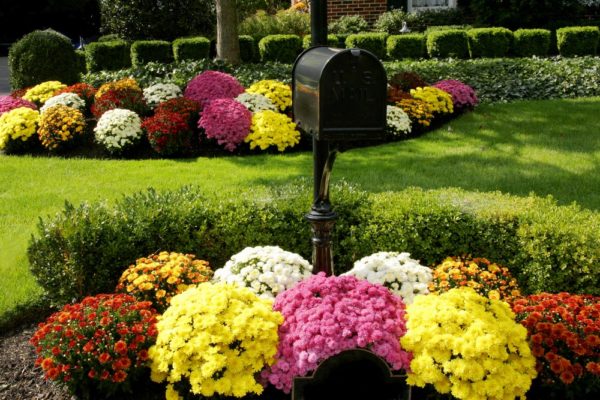

Decorative trees - white-flowering balls
Ornamental trees - bird cherry Prunus padus "Nana" look gorgeous in gardens. This tree, 3-4 meters high, has a dense spherical crown. Branches with a scent of bitter almonds. The foliage is small, dark green in summer, crimson-red in autumn. In May, the whole tree is simply strewn with white tassels of flowers. Then berries are formed, black and red, quite edible. Bird cherry is undemanding to soil, tolerates temporary dryness well and can withstand frosts.
Catalpa bignonioides "Nana" will look even more interesting for the southern regions. She has large, bright green leaves and an almost perfectly round crown.
One of the most unpretentious ornamental trees is robinia pseudoacacia or white acacia. She tolerates drought, undemanding to the soil. Robinia "Umbraculifera" variety is very interesting - with a regular spherical crown. It grows rather slowly, but that's not bad either.Over the years, the branches become more and more curved, which is especially attractive in winter, when the tree is without leaves.
For small-sized gardens, the shrub cherry Prunus eminens "Umbraculifera" is good, with a dense, regular spherical crown. In the spring, the whole is covered with white flowers, then covered with fine glossy foliage. The height of an adult tree depends on the height of the stock. Like all cherries, it loves the sun and fertile soil.
The stem and site of vaccination needs protection from burns and rodents in the spring. Can be tied with reeds or non-woven fabric. Sanitary pruning is carried out periodically. This shrub cherry will be an excellent decoration for a flower bed or lawn. You can plant her as a tapeworm. Or you can put it in a container and decorate the gazebos and the terrace. It will grow great too!
Unfortunately, very often in small dachas there is no fruit or ornamental garden. Only a few trees with poorly formed canopy grow along the fence under the wires.
But to lay a garden of decorative trees, so that it would be pleasant to manage and admire, both novice summer residents and real lazy people can do it!
And a few simple tips in the end:
- plant low-growing trees along power lines,
- low trees are good on the playground. They can be dropped off right next to a bench, swing or sandpit. So they will create shade in the summer heat and will not shade the lawn, which is also needed.
See how many different garden planting options are there. Let your garden delight with its appearance in any season!
What other ornamental trees are suitable for creating a garden? We will continue to select spectacular plants for the garden.
Ornamental trees with a weeping crown
Weeping forms of trees look great in gardens. Imagine the branches of white willow (silver) and Babylonian willow hanging down to the ground. These trees are quite large - up to 25 m in height and 10 m in width. They grow very quickly. Best of all - in lighted areas and fertile soils. They tolerate moisture quite well. They are especially good on the banks of a large reservoir. Hanging branches lean towards the water itself and sway at the slightest breeze.
Of course, such large trees are suitable for large areas. For a small garden, warty birch is suitable. Tree up to 5 m in height. Undemanding to care. Prefers loamy soils without waterlogging. Birch will sometimes need to be treated for aphids.
Rowan is also good in the garden. It also differs in unpretentiousness. It is reconciled with partial shade and requires minimal maintenance.
In the southern regions, you can plant beech and hornbeam.
There is also a wonderful variety of weeping beech Fagus sulvatica "Purpurea Pendula". He will definitely draw attention to himself. What is the purple foliage of this tree.
White mulberry Morus Alba "Pendula" looks very elegant as a tapeworm in the summer cottage, besides, its sweet fruits are edible. Or you can plant weeping apple varieties Malus "Pendula" or cherry blossoms Prunus subhirtella "Pendula plena rosea". In the spring, the trees are strewn with pink flowers.
And in summer, the graceful branches of these trees reach the very ground, creating a living hut. So convenient for a green gazebo, summer bedroom or children's house. A sprawling crown with curving branches is given by Japanese sophora, rough elm and common hazel.
Decorative trees - weeping miniatures
Are there more compact forms of weeping trees? Sometimes it is necessary to decorate the shore of a small summer cottage or stream. There is. Up to 1.5-2 meters high. It's all about the height of the vaccine. The goat willow will become a real decoration of the garden. It is also interesting in that in the spring, during flowering, everything is covered with fluffy earrings.
Like all willows, it tolerates floods well, loves fertile soils, but tolerates a lack of nutrition and watering. Only thinning pruning is needed. In addition, hanging branches can be shortened.
Very popular among gardeners and a small tree - tree caragana. The tree attracts with its dark green openwork foliage and yellow hanging flowers. Grows well in sunny areas and in partial shade, unpretentious, can grow with slight soil salinity.
Preparation for wintering
The main algorithm for preparing a plant for wintering, regardless of the chosen method:
- 2 weeks before the expected frost, the plant is fed with nitrogen fertilizer or organic matter;
- pruning, removing damaged branches and faded buds;
- carry out sanitization against diseases and pests.
Recommendations for preparing wintering by region:
- Moscow region - mid-October;
- Leningrad Region - early October;
- Ural - end of September;
- Siberia - mid-September;
- Crimea peninsula and southern Russia - end of October.
The dates given are relative. Therefore, the florist must independently control the downward trend in temperatures in his region.
Stages of autumn care for perennial chrysanthemums and preparing them for winter


Garden perennial chrysanthemums are rightfully considered the decoration of the autumn garden. They add bright colors to the flower bed and fill the air with a tart scent when other plants finish blooming. Today we will talk about caring for chrysanthemums in the fall, preparing for winter.
Not all gardeners know that chrysanthemums need care no less than the capricious beauties of roses. What is the care of chrysanthemums in autumn, how to keep flowers in winter, is described in the article below.


Work on the preparation of chrysanthemums for the winter period begins in September, when the plant still blooms profusely. In the southern regions, the deadlines for work are postponed to October, in the north, leaving begins in August.
Chrysanthemum care consists of:
- in fertilizing bushes with fertilizers;
- trimming the tops;
- treatment against diseases and pests;
- in the shelter of bushes for the winter or digging up plants for storage at positive temperatures.
Chrysanthemum storage in winter
There are several options for keeping the plant safe during the cold season. Gardeners did not come to a consensus on determining the most successful method, but many argue that chrysanthemum winters well in the open field.
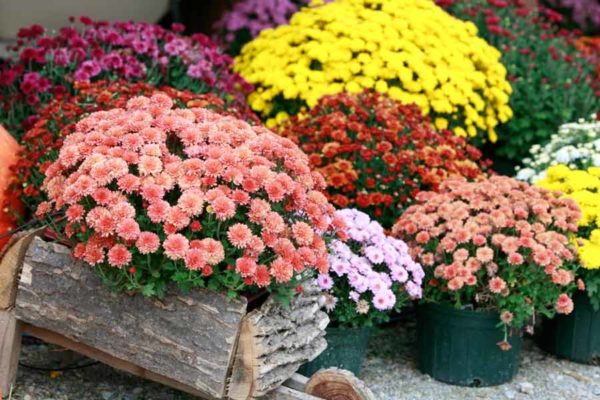

Chrysanthemum globular: wintering in the open field
Chrysanthemum is frost-resistant, but leaving it in the exhaust gas for the winter without shelter is not worth it. The soil under the plant must be mulched. Fallen leaves, peat, or soil are used to create mulch. After the temperature drops to -5 degrees, the bush is covered with a non-woven material, which is spread over the surface of the soil.
The shelter is removed in the spring, after the temperature rises to +5 degrees in the daytime. Top dressing is applied to the soil no earlier than April.
How to store globular chrysanthemums in a cellar in winter
After the ambient temperature drops to 0 degrees, the plants are dug out of the open ground and cleaned off the ground. The underground mass is placed in fabric bags, the plants are placed in wooden or plastic boxes.
During wintering, it is necessary to check the safety of the planting material. Landing in open ground is carried out after the spring temperature rise.
How to store globular chrysanthemums in a flowerpot in winter
The plant can be stored in a flowerpot in winter, but this method is beneficial to use if the grower has few varieties. This technique is convenient for low-growing bushes - they are simply placed in a flower pot and provided with care until spring.
Ensuring wintering in an apartment, you need to remember to observe the temperature regime. The plant will die at high rates, the room should be no more than 15 degrees. In winter, they provide moderate watering after the earthen coma dries out, they refuse to fertilize.
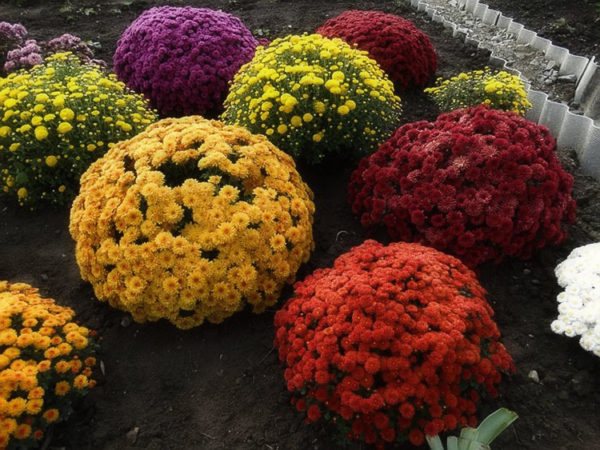

Nipping chrysanthemums
Pinching bushes is a must-have procedure for caring for autumn flowers. This procedure allows you to make the bush more luxuriant and colorful. It is used more for ball forms.
You can pinch both plants grown in the open field and those specimens that grow in a flower garden.
Small-flowered and medium-flowered
The first pinching is carried out at bushes about 10-12 cm high - pinch off the top of the central stem in order to stimulate the development of lateral stalks. To obtain a more lush crown and lush flowering, this procedure can be repeated - the interval between the first and second pinching is 30 days. The second time, not only the central shoot is pinched off, but also the lateral stems.
For these varieties, the pinching need not be carried out, then the plants will have a normal crown.


Chrysanthemum large-flowered Zembla yellow
Large-flowered
These varieties can be pinched at a height of at least 10 cm. The manipulation is carried out two or three times. In addition to pinching, pinching is carried out - the removal of shoots growing from the leaf axils. Flower buds are plucked together with young stems. This procedure is carried out every day starting from the second half of July, and in August and September - every three days.
Additionally, puncturing is performed - the selection of the best flower bud. Inflorescences that form from the first or second crown bud are best suited for cutting. Of these, choose one larger and more beautiful, the second is removed. The spring bud, which forms in May, is also removed.
Reviews and comments
Reviews and comments of flower growers confirm that the spherical chrysanthemum is unpretentious. It is very simple to get a blooming flower bed on your site, the main thing is to remember the basic rules for care.
My acquaintance with the plant began with the fact that my mother gave the delenka. It was a white, short chrysanthemum, which, despite its small size, bloomed very luxuriantly. Flowering lasted from September until frost. I decided to store it in the open ground, made mulch and covered it with burlap. In the spring the bush turned green and hairy, and in the fall it had a lush hat of flowers. I was delighted and the next year I found many different varieties.
I don't understand why the rose is considered the queen of the garden, it is capricious, the buds do not last long and you have to spend energy on pest control. My queen is chrysanthemum, there are more than 40 varieties in the collection and I cannot stop. It is very simple to grow a bush and bring it to flowering; care consists in watering and feeding. At the first meeting, I dug for the winter, and then decided to leave it for the winter in the garden - everything is fine.
Due to my health condition, I had to leave the summer cottage and move into an apartment, but I could not say goodbye to my beloved chrysanthemum. I dug and planted the houses in a flowerpot. Yes, this plant does better outdoors, but it grows well in a pot. It blooms 2 times a year, in spring and autumn. I want to add to my home collection.
I always scolded my wife for planting flowers in all the free space in the country. I thought they were useless until I saw the autumn flowering of chrysanthemums. It's amazing, the harvest is harvested, everything turns yellow, there is practically no sun, but they are blooming. There are no words.
Care errors
Due to improper care, not all growers manage to keep cut chrysanthemum varieties until spring. There are several reasons for this:
- untimely or excessive fertilization, as a result of which the plant becomes weak or begins to develop intensively before the start of wintering;
- too late pruning and digging of non-resistant varieties - frozen bushes, transferred to storage in the basement, after a while rot, turn black and die;
- lack of a dormant phase, which stimulates premature growth and development of bushes;
- pruning and storing sick specimens that die without proper treatment over the winter.
Characteristics of the species
Chrysanthemum multiflora belongs to the Asteraceae family and has small-flowered inflorescences.In the process of development, the bushes of this plant independently take on a rounded shape, which explains the origin of the second name of the flower - garden spherical chrysanthemum.
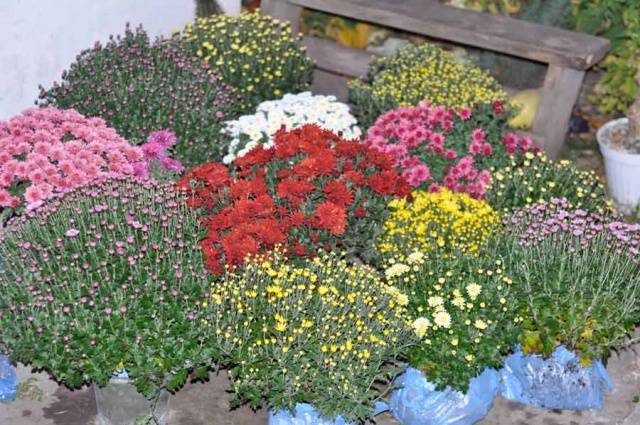

Chrysanthemum perennial globular is a relatively young species, but already has several hundred varieties and hybrids. This flower is loved, first of all, for its decorativeness - compact bushes of the correct shape do not need to be formed and pruned, moreover, they can bloom in absolutely any shades (now there are spherical chrysanthemums with blue and even green flowers on sale).
The spherical Multiflora has many advantages:
- Long term "life" - a perennial flower can grow in one place for 4-5 years, after which it must be divided and simply transplanted to another place.
- Multiflora is unpretentious, it develops well on any soil, and the only thing that determines the beauty of a flower is a sufficient amount of sun.
- The high decorativeness of neat spherical bushes makes it possible to widely use Multiflora both in landscape design and for decorating balconies, gazebos, and interior interiors.
- The variety of varieties and shades makes it possible to create interesting combinations using spherical varieties.
- The flowering time of the spherical perennial chrysanthemum is quite extended - the flowering of the species can last from late summer until the first severe frosts.


Varieties and varieties
Recently, spherical chrysanthemums have enjoyed unprecedented popularity. And the number of varieties reaches four thousand hybrids of all kinds of colors, including blue and green shades. Only viewing numerous photos will help you decide on the choice of a variety. Low bushes of chrysanthemums are densely dotted with flowers, which gives them a special charm. These plants bloom from August to the very frost.
The bushes of such a chrysanthemum are in the shape of a ball, densely covered with flowers.
Some of the common varieties are:
- "Ida" is a ball-shaped bush up to 60 cm tall, dotted with small (up to 3 cm in diameter) flowers. Blooms from September.
- "Knop" - is distinguished by abundant flowering. A short bush (30-35 cm) during flowering is completely covered with yellow flowers, the number of which reaches 160 flowers at a time.
- Multiflora is the most widespread variety. Small flowers have a very wide range of colors. Blooms from early September.
Classification
Spherical bushes of flowering chrysanthemums can be found in gardens and parks, in flower beds and alpine hills, they are often grown in flowerpots or boxes - all this is one variety, only plant varieties differ.
Read also Use of vinegar in everyday life
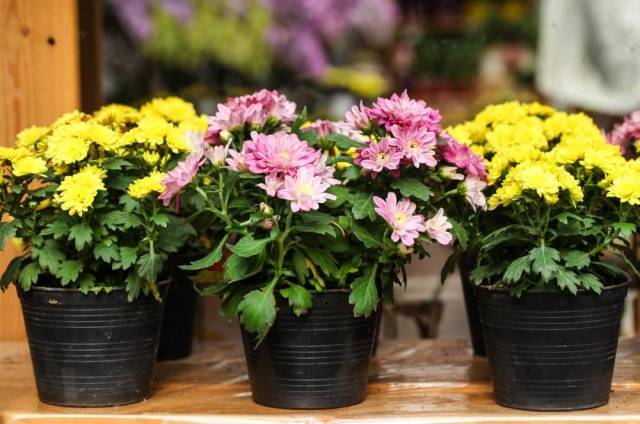

About four thousand varieties and hybrids of Multiflora are classified according to several criteria. One of the main signs of dividing chrysanthemum varieties into groups is the size of the bush. Depending on the length of the stem, there are:
- dwarf chrysanthemums, which can also be called undersized - the bushes of these varieties usually grow to a maximum of 25-30 cm;
- medium-sized spherical chrysanthemums can have a height of 30 to 50 cm;
- tall varieties form round bushes with a diameter of about 60-70 cm.
By the way, novice growers should understand that Chinese chrysanthemum and Multiflora are one and the same. But Korean chrysanthemums are another group: the inflorescences of these plants are larger, and the bushes are not able to take the shape of a hemisphere without outside help.
The flowering time of spherical chrysanthemums may also differ slightly, but the common quality of all varieties is their ability to bloom until the real cold. By choosing Multiflora with different flowering periods, you can create a unique composition of these flowers and enjoy their bright colors from late summer to the last days of autumn.
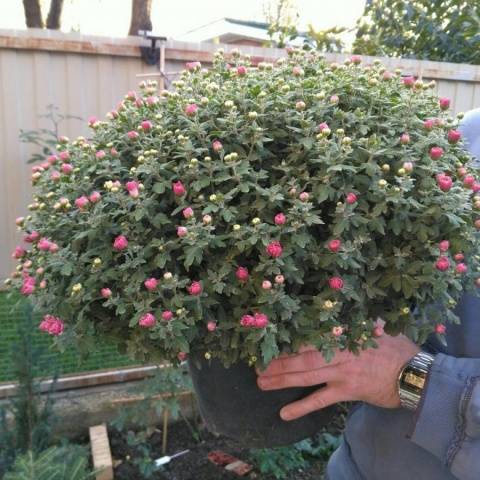

Given the timing of flowering, varieties of spherical chrysanthemums are divided into the following groups:
- early flowering, blooming their buds already at the beginning of August;
- mid-flowering varieties delight with abundant flowering in mid-September;
- late varieties bloom not earlier than the first days of October and bloom until snow and frost.
There are many varieties of perennial Multiflora, below are just a few of them.
Branbeach white
The variety is medium-sized - the bushes of this chrysanthemum can grow up to half a meter in height. The inflorescences of the plant are white, small-flowered, numerous. Flowering time is mid-August.


Branindio Branindio
This globular chrysanthemum blooms in mid-September. Her inflorescences are golden yellow, very bright, in perfect harmony with the tones of the autumn garden. The diameter of the bushes is decent - about 50 cm.
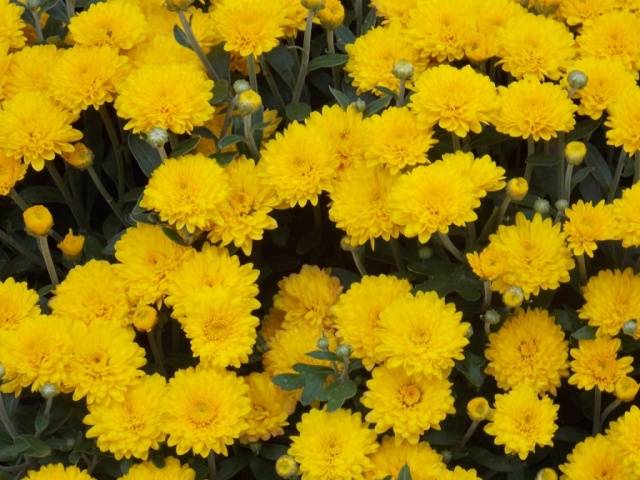

Branbeach Sunny
An early flowering variety with bright yellow inflorescences. Bushes of medium height - about 0.5 meters. The buds open in the second half of August.
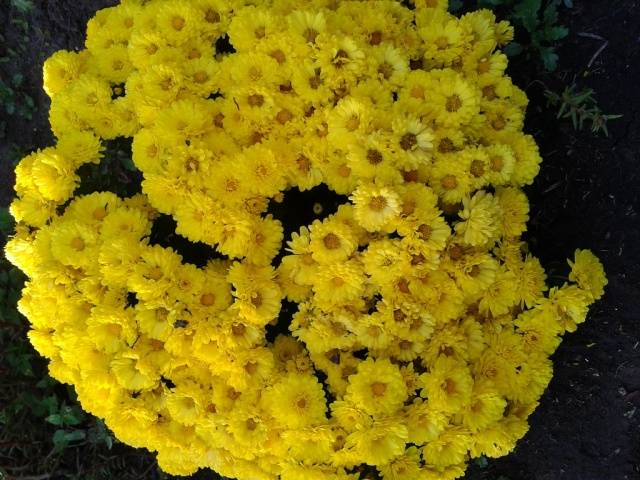

Branhill red
Compact early flowering bushes, the height of which does not exceed 40 cm. The flowers of this Multiflora are of a beautiful wine-red hue.
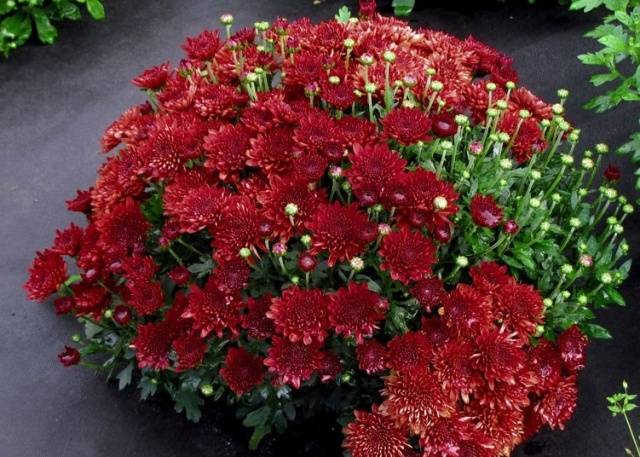

Branfountain salmon
In mid-September, this medium-sized variety begins to bloom with bushes about 50 cm tall. Chrysanthemums are covered with delicate pink flowers.
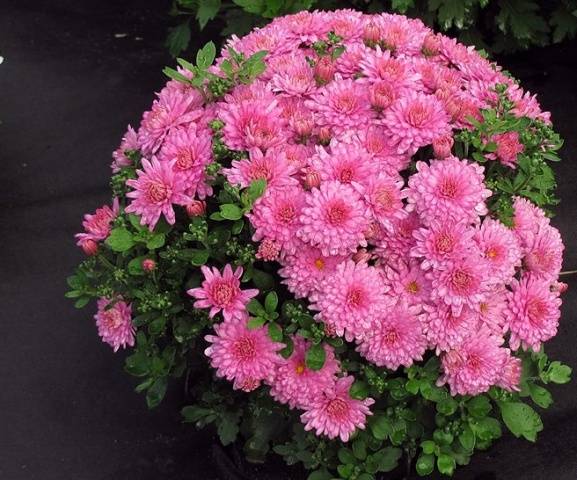

Branfountain lemon
Lemon yellow globular flowers bloom in mid-September. Medium-sized bushes - about 45-50 cm in diameter.
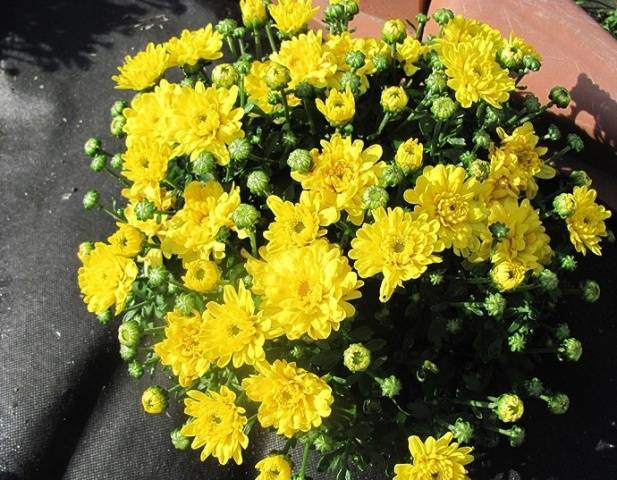

Branfountain purple
This variety of chrysanthemums has lilac inflorescences. Bushes of medium size, bloom in September.
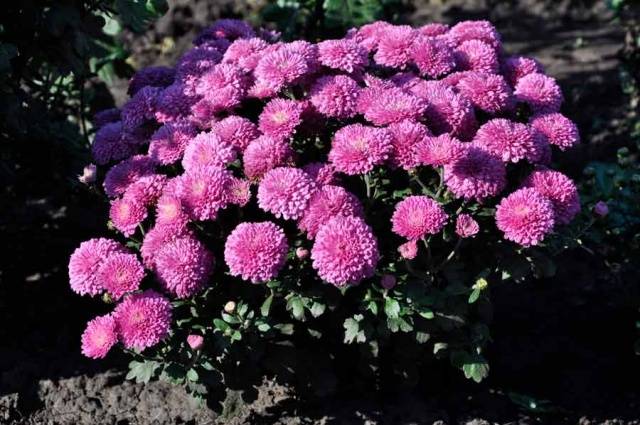

Branbeach lilac
Very bright lilac-pink inflorescences of Multiflora, blooming in the second half of September. The bushes are quite high - about 50 cm.
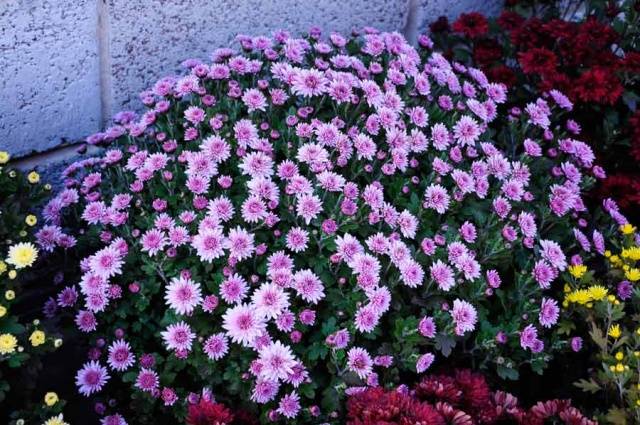

Branbeach orange
The flowers are large enough, with a rich orange hue. Multiflora blooms in September.
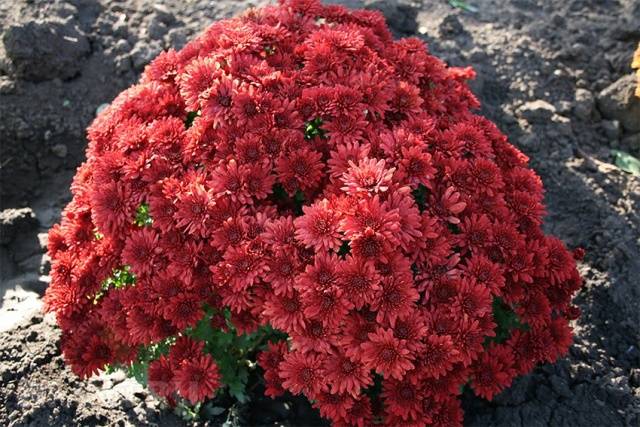

A photo of spherical chrysanthemums of various varieties once again proves their uniqueness. Such a variety of shades and shapes allows you to effectively fit spherical chrysanthemums into almost any exterior of the site and garden.
Globular chrysanthemums in landscape design and in combination with other plants
If you look at the numerous photos of spherical chrysanthemums, you can see that their use in landscape design is quite diverse.
When choosing a place for chrysanthemums, the size of the bush must be taken into account. Tall plants will be better combined with the same tall neighbors, and short ones, respectively, with small plants. But experimenting should not be avoided. You can plant a bed of chrysanthemums of different heights and shades, placing smaller varieties in the foreground.
Spherical chrysanthemums with conifers look great. Bright, rounded shapes smooth and liven up austere evergreen crops.
Spherical chrysanthemum in landscape design
Low-rise varieties of this perennial flower are widely used to create mixed borders. In addition, they can mark the boundaries of the beds and paths.
The variety of colors of globular chrysanthemums allows you to experiment with color combinations. For example, a green lawn would be the perfect backdrop for white chrysanthemums. And yellow flowers will look spectacular against the background of emerald grass or silver leaves of noble elimus.
Spherical chrysanthemums in combination with cereals, marigolds or cosmea will look interesting.
In autumn, when most of the plants have already faded and are getting ready for the winter, bright flower beds, composed of chrysanthemums of various colors, will delight your eye with festive flowers. Plant yellows, reds, whites and pinks and enjoy a riot of colors.
Chrysanthemums of different colors look very beautiful on the same flower bed
Ball-shaped chrysanthemums are ideal for mixborders. In addition, these lush flowers can be used as a vibrant center of the lawn, along the edges of which cold-resistant plants such as snapdragon and calendula can be planted.
Sometimes gardeners grow chrysanthemums as a home potted flower. Vases with these flowers decorate terraces and balconies. But not all varieties are able to show their full potential in a confined space.
In general, caring for chrysanthemums does not burden and does not require any special skills and abilities. In order for these beautiful autumn flowers to delight you until the very frost, it is enough to follow simple rules. A little attention and patience - and your garden will be irresistible.
Growing rules
There is nothing difficult in planting and caring for spherical chrysanthemums - these are very unpretentious flowers. The only difficulty lies in preparing Multiflora for the winter period. The method of wintering is largely determined by the climatic conditions of a particular region and can be chosen by the florist independently.
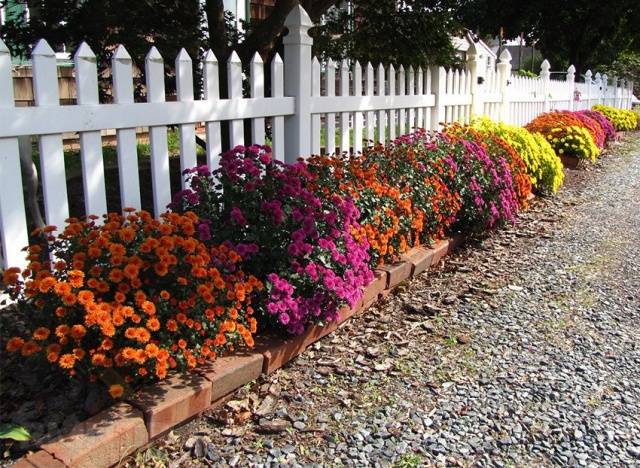

Reproduction and planting
Ball chrysanthemum can multiply in several ways, but the most effective and affordable option is the division of an adult plant. Given the low frost resistance, the planting of spherical chrysanthemums in the fall is not carried out. The optimal time for planting these flowers is mid-April (the plant can withstand small return frosts without problems).
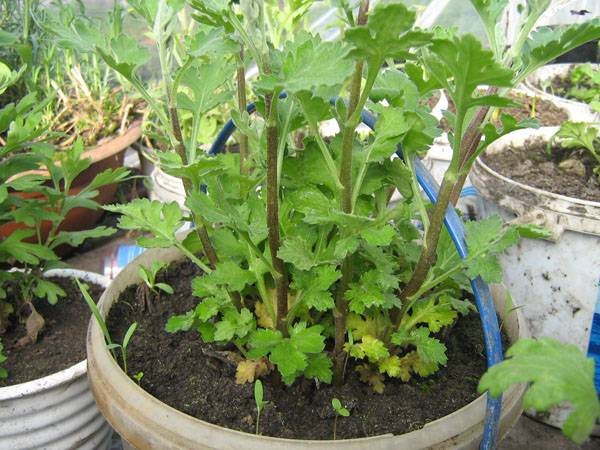

The planting technology is recommended as follows:
- Prepare the soil before planting flowers. The soil for Multiflora should be loose and moderately nutritious. Too much fertilizer will lead to an increase in green mass and poor flowering, so you should not be zealous with fertilizing. It is enough to add a little peat or humus to the soil.
- With an interval of 50-60 cm (depending on the height of the spherical chrysanthemum), holes are made. The holes are about 40 cm deep.
- At the bottom of each hole, you can pour a handful of coarse river sand - it will act as a drainage. A little fertile soil should be poured on top and the wells should be well poured with water.
- The seedling is placed in the center of the hole, its roots are straightened and carefully sprinkled with earth. Do not bury chrysanthemums too deeply - the root system of these flowers is of a surface type.
- For tall varieties, supports may be required, it is better to install them immediately at the time of planting.
The planting is over, now it remains to provide the spherical Multiflora with competent care.
How to care for flowers
The spherical chrysanthemum is not capricious - it is very simple and easy to care for this flower:
- Since chrysanthemums are planted in spring, it is recommended to shade the plant immediately after planting from the burning sun. For these purposes, it is better to use a non-woven material, it is positioned so that the fabric does not touch the Multiflora leaves.
- Chrysanthemum will have to be watered often, because it is moisture-loving. It is better to use rainwater or settled water for irrigation. If this is not possible, you can add two drops of ammonia (per bucket) to plain tap water to soften it.
- In the year of planting, Multiflora is not fertilized. Subsequently, it is recommended to apply fertilizers twice a season: at the initial stage of the growing season (mullein or humus) and in the bud-laying phase (50 grams of superphosphate for each square meter of the flower bed).
- If chrysanthemum bushes are planted in partial shade or grown from seeds (in this case, there is a high risk of losing genetic qualities), it may be necessary to adjust the shape of the plants. Immediately after planting, the top is plucked out of the sprouts, after three weeks the procedure is repeated, removing the entire upper part of the central shoot.
- Among diseases and pests, Multiflora is most often attacked by powdery mildew and caterpillars. For the purpose of prevention, it is recommended to observe the irrigation regime, loosen the soil and spray with special preparations.
Wintering rules
How to grow spherical chrysanthemums is clear, now it remains to figure out how to preserve them until next spring. These perennial flowers could easily grow in one place for 4-6 years, but in most Russian regions this is impossible - the bushes have to be dug up annually for the winter.
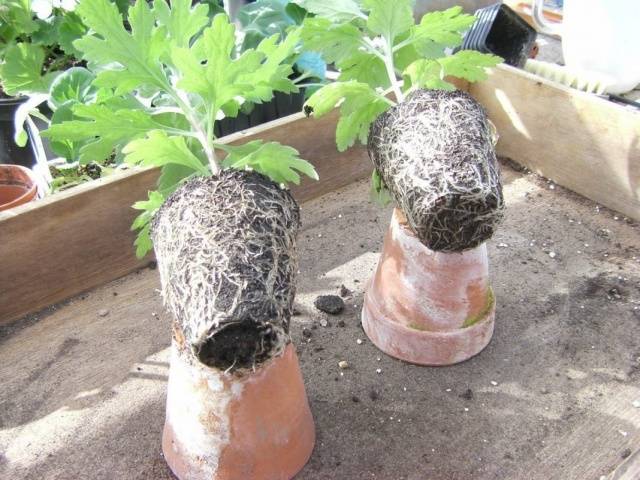

In the warmest regions, chrysanthemums can winter in flower beds or in pots.Before the onset of cold weather, it is recommended to cut the stems of flowers to 10-15 cm and cover their roots with a thick layer of organic mulch.
Where winters are more severe, drastic measures cannot be avoided - spherical chrysanthemums will have to be dug out for the winter. To prolong the variegated flowering, you can install a plastic frame around the bushes. When the stems begin to dry out, they are cut off and the rhizomes are dug out. Flowers are placed in sand or in soil mixed with sawdust, sand, peat (for better moisture retention) and removed to a dark, cool place.


At the end of March, spherical chrysanthemums are taken out of shelters and placed in a warm place under the sun's rays, so the flowers will begin to wake up. When the ground warms up well enough, you can return Multiflora to the flowerbed.
When purchasing rhizomes for planting, you need to take into account several nuances:
- It is advisable to purchase seedlings and rhizomes in the spring before planting in the ground. Thus, the quality of the planting material can be monitored.
- Before buying, you should carefully examine the rhizome: it should not have spots, rotten areas, dry fragments.
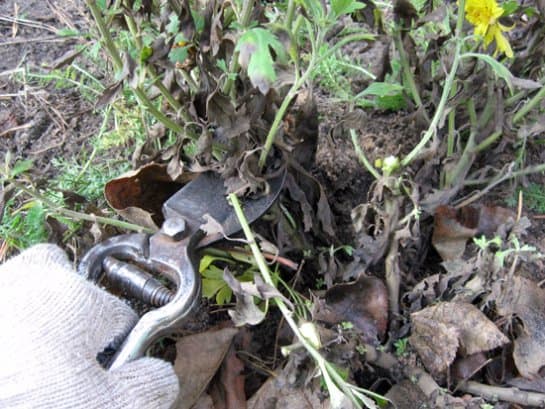

An excellent time to plant a globular chrysanthemum is early spring, when young grass appears. The soil has warmed up so much that it can be dug up. Before planting rhizomes, they need to be woken up. To do this, they are placed in a large container and sprayed with settled water. So leave them in a bright place, protecting them from direct sunlight. After 3-4 days, after the emergence of sprouts, they are planted.
How to care for a spherical chrysanthemum: grow and propagate?
Globular chrysanthemum - reproduction
It is necessary to plant spherical chrysanthemums in April or at the very beginning of May. The bush is divided into parts one by one. If this process is postponed and started around mid-May or early June, then the bushes will be undersized and the diameter of the ball is noticeably smaller. If you neglect seating, then this will lead to a slowdown in the growth of the bush. Its root system forms a lignified taproot, which interferes with the emergence and development of new shoots.
Immediately after dividing, spherical chrysanthemums are planted in the ground. Young seedlings are not afraid of small spring frosts, especially after covering them overnight with buckets or other similar items.
Spherical chrysanthemums - how to keep in winter?
In the warm southern zone, the wintering of the globular chrysanthemum takes place without special preparation. There are, of course, winter-hardy varieties that are able to survive in more severe conditions. To do this, it is enough to cover them to prevent freezing and light penetration. The easiest and surest way to preserve spherical chrysanthemums bought in the fall in winter, put them in a cool, dark place and wake up the plant in April. The living conditions will not suit them. It is important that immediately after the onset of heat, the shelter is removed from the beds, otherwise the flowers will get wet and die.
Chrysanthemum spherical, multiflora
author Korovina I., photo by author
Chrysanthemum multiflora
- a relatively new group of plants among the long-known and widespread varieties of chrysanthemums. Due to the spherical shape of the multiflora chrysanthemum bush, which is completely covered with numerous flowers, this ornamental plant has earned an alternative name “
globular chrysanthemum
».
The emergence of profusely flowering chrysanthemums multiflora modern floriculture owes hybridization and selection work.
Multiflora group (spherical)
Multiflora is a group of low-growing, small-flowered, abundantly flowering chrysanthemums with a spherical bush. Flowers are located throughout the crown and look in all directions - in an arc. This type is genetically incorporated, that is, the ball is obtained without effort on your part - it does not need to be pinched and shaped.
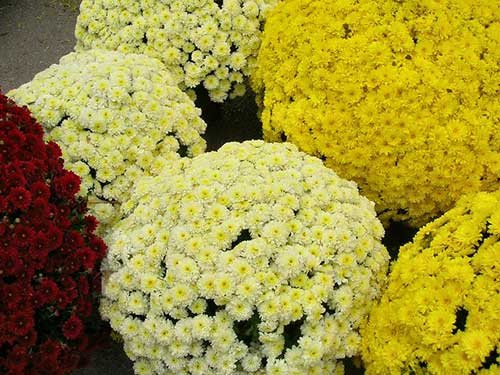

In the photo: chrysanthemum multiflora globular blooming in autumn to prolong summer with its bright colors.
Low-growing (up to 30 cm) - usually early, and from taller (up to 50 cm) huge balls grow, bloom in late autumn. With an incorrect planting, the bush may turn out to be slightly raised above the ground, but the crown itself still grows in the form of a ball.
This is why multiflora is multi-flowered - many medium (4-5 cm) and small (about 2 cm) flowers, both double and not. The undersized ones do not have multiflora, the flowers can also be numerous, but they grow like a lush bouquet.


Chrysanthemums are quite cold-resistant and continue to bloom right over the first snow. Only persistent frost with freezing of the soil will make the leaves turn black and the flowers wither. But the root won't freeze. At this time, without cutting, they spud the bush with earth, peat and sprinkle dry foliage under the roots. Perhaps additional cover with spruce branches just before the frosts.
In the spring, they break the bush and remove the dry stems of last year. Young green shoots appear from the root, which are then used for grafting.
Planting can be done with grown cuttings or seedlings obtained from seeds. Cuttings are planted in the ground in April, May, June. The timing of planting affects the correct development, duration and abundance of flowering.
Early varieties of multiflora that bloom in August include:
- "Sunbeam Corall" - coral flowers with a bush height of 40 cm.
- "Amor Dark Pink" - pink flowers, 4 cm in diameter.
- "Meridian Dar" - flowers only 3 cm in diameter, with a burgundy color.
Varieties that bloom in September:
- "Branroyal Yellow" - height reaches 70 cm, yellow flowers.
- "Branchili" is a 40 cm bush with 4 cm brown flowers.
- "San Remo Runner" - medium-sized bush, flower diameter 5 cm, white petals at the edges, red core.
Late flowering varieties include:
- "Pepita" (white-yellow) - height up to 50 cm.
- "Button Rose" (pink ball) - profusely flowering, with very small flowers.
- Staviski White is medium-sized with pale white flowers.
How it all began
Having met the beauty for the first time, I realized one thing - the owners-sellers do not want to share information. It is understandable, suddenly I am a potential competitor, who by the fall will outshine the entire local collective farm market with huge bushes. However, not all so simple. I had to learn myself.
In September I bought three balls. The hostess tried to "load" me with the names of varieties, but I did not really take the information. But it turned out in vain, the name of the variety should have been written down. When there are not many bushes, it does not matter. However, I was so carried away by the spherical that I decided to look for more varieties. And how to search if you don't know which ones you have and which ones you can buy.
Having brought the "balls" into the yard, I put them in the sunniest place. There was no chapel to delight. The seller warned that Korean chrysanthemums hibernate well and do not need to be dug up. And so I did. Since she was afraid of losing, she carefully covered her with spruce branches - this was a fatal mistake. The chrysanthemum bushes did not freeze, but simply got stuck and disappeared.
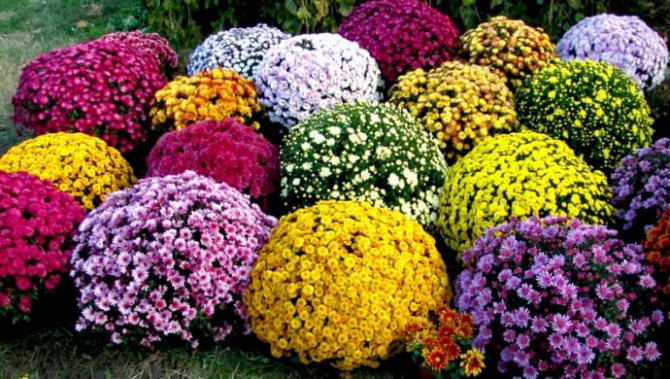

How to care
The main task when caring for a perennial spherical chrysanthemum is to prepare it for wintering, because it does not tolerate frosts, otherwise these flowers are unpretentious. There are several ways to help your garden ball chrysanthemum survive the winter:
- insulate flower beds;
- dig up the root system to preserve it in the winter.
Without digging, due to the danger of freezing, these chrysanthemums can calmly grow in one place for at least 5 years, because they are perennial plants. The choice of a specific wintering method depends on the place where the spherical chrysanthemum is grown; in the southern part of Russia, it can remain in a flower bed in winter. But you need to cut the stems a little and mulch the root system. Also, advice on how to competently survive the winter can be given by sellers in specialized stores, where it is desirable to purchase planting material.
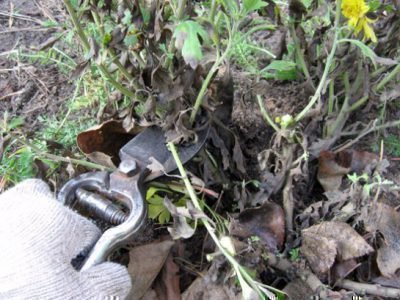

Pruning a bush before wintering
Another option for wintering spherical chrysanthemums: shortly before the end of flowering, make a fence of plastic bottles around the flower bed. After the stems have dried, they need to be cut off by 10 cm, the roots should be dug out, and the flowers should be placed in a dark and cool place, covered with sand, sawdust or spruce branches.Also, flowers can be placed in deep vases for the winter. The wintering site should be chosen so that there is free air ventilation to avoid mold growth. In early spring, when the sun begins to warm more actively, it is necessary to return the flowers to the street.
Pruning is not necessary when caring for these chrysanthemums - their crown forms naturally, but some gardeners pinch the tops 3 weeks after planting, and after a while they partially cut off the central shoot. It must be remembered that flowers cannot be cut during flowering.
Another important task of the gardener when growing this plant is to protect it from the sun's rays in hot summer, otherwise the leaves will receive a severe burn, which is diagnosed by their brown color. As a preventive measure, you can make a nonwoven canopy that will not touch the plant. Diseased leaves must be disposed of immediately.
Watering is a crucial part of care, it is not only regularity that matters, but also the quality of water, settled or rainwater is best suited. The water should be soft, for this you can drop ammonia into it. In hot summers, water with small but frequent portions of water. Thanks to competent watering, the flowers become more lush, the lignification of the shoots does not occur.
In relation to spherical chrysanthemums, the principle operates - it is better to give less fertilizer than to exceed the dose. When placing fertilizers in the soil, you must adhere to the following rules:
- do not fertilize the soil for a year after planting;
- during the active growth of flowers, organic fertilizers need to be applied, it is best to choose a mullein or humus;
- when buds are formed, superphosphate must be added.
If the plant develops well, then fertilization can be one-time - in the spring before the flower buds appear.
We must not forget about the periodic loosening of the earth, which will provide free access to moisture and air. Spherical chrysanthemums are not immune from disease and attacks of harmful insects. The most dangerous are caterpillars, aphids, spider mites and powdery mildew, which spoils the leaves, changing their shape and color. Their appearance can be caused by excessive watering or sudden temperature fluctuations. In addition to observing all the rules of care, you can protect yourself from them by treatment with special preparations, the most effective are those that contain copper. Spraying is best done in summer. Another way to protect yourself from pests is to change the top soil layer.
Despite belonging to perennial crops, it is advisable to transplant spherical chrysanthemums to a new place 2 years after planting by digging and dividing the bush, this will improve the appearance of the plant and help preserve varietal characteristics.
Application in landscape
The use of spherical chrysanthemums in the landscape is diverse, the main thing is to take into account the height of the bush, the color of the buds, and the periods of flowering.
Chrysanthemums are ideally combined with any plants. They are often combined with low-growing varieties of garden plants. Especially advantageous "balls" look against the background of green plants.
Spherical varieties are used to decorate alleys, curbs, rabatok. They decorate terraces, recreation areas, placing flowerpots with them.
To decorate the site, it is recommended to choose undersized varieties with small flowers. These can be Korean varieties, spherical, and other types. Correctly selected plants will decorate the garden from July until late frosts. If you regularly remove faded buds, you can extend flowering up to four months.
Chrysanthemums look perfect with a wide variety of plants. They are unpretentious, withstand any neighborhood, even with ornamental cabbage. Bright, colorful shrubs are able to accentuate evergreen shrubs. Plants look great against the background of a green lawn.And no matter what chrysanthemums are planted with, they will always be appreciated, because these flowers are noble.
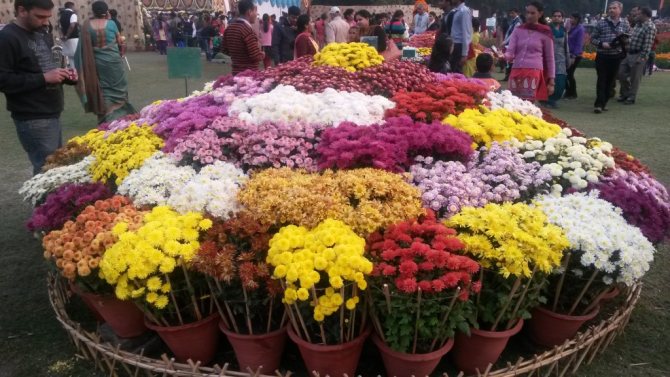

Spring works
In the spring, as soon as the snow melts and it becomes warm enough, spruce branches or sawdust should be removed from the chrysanthemum. Excess moisture must go away so that young shoots are not attacked by rot and mold. But if the nights are cold, cuttings should be covered with rags in the evenings.


In general, it is not advisable to grow one chrysanthemum bush for more than two years in a row - there are fewer flowers, and the bush itself disintegrates. Therefore, at the end of the second season, the bush should be divided into cuttings and transplanted. Then the flower bed will delight you with its beauty for more than one year.
Reproduction
Planting chrysanthemums "multiflora" and care in the open field implies periodic renewal of plants. For this purpose, flowers are propagated. New specimens of spherical chrysanthemums are obtained by dividing a bush, by rooting cuttings. They are not propagated by seeds, since varietal properties are lost. But planting and caring for Korean chrysanthemums is possible by growing plants from seeds.
The division of the bush is carried out according to the following scheme:
- The plant is carefully dug out of the ground. During this procedure, it is necessary to monitor the safety of the root system.
- The roots are freed from the soil. Immediately inspect them. Rotten and dry roots are removed.
- The rhizome is divided into sections, leaving 1-3 green petioles. Planted in a prepared flower bed.
This method makes it possible to quickly get the right amount of chrysanthemums. Planting perennial chrysanthemums and leaving in the fall comes down to getting new specimens. This is the best time to breed.
You can propagate the plant by cuttings at any time of the year. For this, several good shoots are cut from the bush, at least ten centimeters long. They are rooted in moist soil, consisting of humus, sand and earth. In order for the material to take root faster and better, greenhouse conditions are created for it. After about a month, the cuttings are planted in a flower bed, flowerpot.


Care of seedlings of spherical chrysanthemum after mailing
Having received the long-awaited parcel with spherical chrysanthemum seedlings, which have been on the way for several days, you need to immediately unpack the parcel and take proper care of the plants.
It is important that before planting in the garden, chrysanthemum seedlings quickly come to their senses after a long shipment in the absence of light and fresh air. After all, for cuttings sent by mail, this is undoubted stress: from a bright and warm greenhouse to get into a dark box for several days, and then abruptly - under the sun, under the breeze and into the cool night garden ...
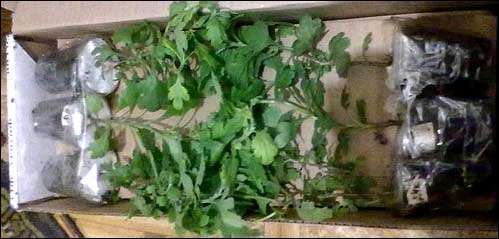

In the photo: cuttings of multiflora chrysanthemum packed in a parcel box
After unpacking the cuttings of the multifor chrysanthemum, it is advisable to hold the seedlings outside in partial shade for a couple of days so that the plants adapt to the new conditions. If possible, in the morning and in the evening, it is advisable to spray seedlings of spherical chrysanthemum for 4-5 days (with a solution of Epin or Zircon).
When planting spherical chrysanthemum seedlings in open ground, do not forget to build shading for them for the first time, as is done for any planted seedlings. Alternatively, use old, bottomless buckets or other similar temporary shelters to shade the planted plants and protect them from the wind - at least for a week, until the chrysanthemum seedlings take root.
Globular chrysanthemums: planting, wintering, reproduction, cultivation and care
Therefore, the spherical chrysanthemum should be watered regularly, but moderately (the soil should be neither dry nor too wet).
After waiting for the end of the abundant flowering of multiflora (in October-November), you need to almost completely cut off the aerial part of the bush, leaving about 10 cm of stems. This will protect the chrysanthemum from the spread of pests and typical diseases that could affect old stems, and will contribute to better growth of basal shoots in the spring.
As for feeding, humus or mullein infusion is suitable for a spherical chrysanthemum. I feed multiflora chrysanthemum only once, at the very beginning of the growth of young plants.
In too damp weather and with a large difference between day and night temperatures, spherical chrysanthemums are recommended to be treated (once every two weeks) with copper-containing preparations. This will protect chrysanthemum multiflora from powdery mildew, preserve the decorative appearance of the bush.
With proper cultivation and careful care, the spherical chrysanthemum will certainly thank you with abundant and bright flowering.
Irina Korovina (Smolensk region)
All about chrysanthemum
Online All About Plant Reproduction
Online Everything about gardening
Online Garden world
Online
A little about the "Koreans"
Despite the general unpretentiousness of this variety of flowering plants, even among them there are varieties that are especially suitable for growing in our conditions. These are spherical Korean chrysanthemums.
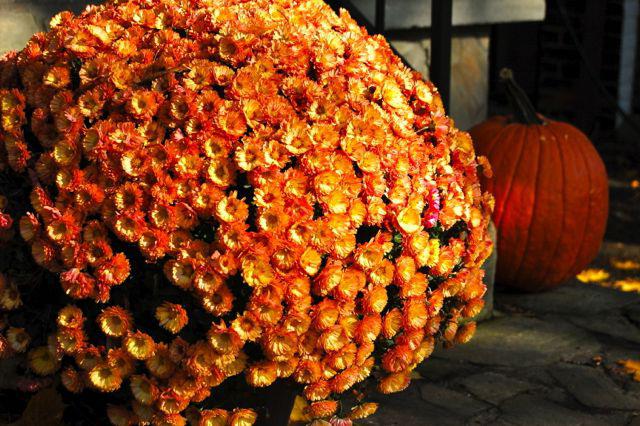

This variety is hybrid. It is divided into several types at once. The first group includes border varieties, the height of which does not exceed 30 cm. They are ideal for decorating a personal plot, since they are distinguished by very early flowering periods, almost complete absence of root growth and the most spherical shape of the bush.
The second type is medium-sized chrysanthemums, the height of which reaches about 50 cm. They are extremely decorative, since among the plants of this group there are varieties with an extremely diverse color of inflorescences.
They are great for creating a variety of group compositions. Unlike the first group, they can be used for cutting. In addition, they may well be cultivated as houseplants.
The third group includes all tall varieties. They are distinguished by late flowering, large inflorescences. Perfect for large areas. Despite its impressive size, the bush is quite compact.
Lush blooms and vibrant leaves: unusual trees
Small-leaved lilac 'Superba' (Syringa microphylla)


A spectacular, short and compact plant often sold in standard form. Feature: the lilac of this very fragrant variety blooms not only in May, like all its "sisters", but also again - in the fall.
Field maple 'Nanum' (Acer campestre)
This maple, recognized in Europe as the tree of 2019, conquers with its thick "hair". In the spring it is very popular with bees, and in the fall it waltzes in a golden-yellow outfit. A plant grafted onto a stem grows up to 4-8 m in height.
Metasequoia glyptostroboides 'Matthaei' (Metasequoia glyptostroboides)
The tree is perfect for planting in a small garden: depending on the height of the graft, the plant reaches a height of 2 to 4 m. The long, light green needle-shaped leaves turn red-brown in autumn and fall off on the eve of winter.
Growing chrysanthemums
Chrysanthemum cultivation can take place both in pots and in the open field. If you decide to plant this plant, then it is worth remembering several important features of multiflora chrysanthemum when planting and caring for:
- First of all, lighting is important. If the shrub is planted in a sunny area, it can prevent late and short-term flowering, as well as protect against the growth of long shoots.
- The soil should be mixed with compost or humus to improve its fertility. It should be light and loose. But do not overdo it - chrysanthemums can grow a lot and bloom a little.
- Chrysanthemum Multiflora should be planted on cloudy, sunny days, in summer - early in the morning or in the evening. The dug hole is first watered with high quality, then drainage is placed, and then soil. It is not worth planting a chrysanthemum too deep, since its root system is superficial, a fossa of about 40 cm will be sufficient.
- After planting, the plant is pinched.The growth point is removed from him. The second pinching is done after 20 days, the shoot and a couple of nodes are removed. Some argue that the shape of the ball in the plant is genetically inherent, so pinching needs to be done only once, and the chrysanthemum will independently take the desired shape. Here each gardener decides on his own, but it is worth remembering that additional pinching does not harm the plant. In the early days, chrysanthemum globular needs shelter from the sun. Non-woven fabrics are used that will not touch the leaves of the plant.
Chrysanthemum multiflora: planting, care and reproduction
author Butrimova S.V., photo by the author
Chrysanthemum multiflora (spherical chrysanthemum), characterized by long and abundant flowering, has gained immense popularity among flower growers in recent years.
Having appreciated all the advantages of a spherical chrysanthemum, many gardeners strive to acquire rooted cuttings of multiflora in the spring for a bright decoration of their garden in late summer and autumn. Often, varietal planting material of spherical chrysanthemums is ordered via the Internet, then a parcel with seedlings is received by mail.
I want to share with the lovers of this wonderful plant some tips for the successful cultivation, reproduction and wintering of a globular chrysanthemum. This article is based on questions about the cultivation of chrysanthemum multiflora, which are most often asked by flower growers.
I must say right away that my advice is not mandatory, but purely recommendatory. Since each grower has accumulated his own experience of growing chrysanthemums in his garden with certain climatic conditions and distinctive features of the soil; there are different physical and financial capabilities.
Columnar ornamental trees
Earlier, poplars were planted for landscaping city streets. Black poplar has the narrowest silhouette. Due to their unpretentiousness and stability, the Bolle poplar and Simon's poplar, immigrants from Asia, were often planted.
But to plant poplars in the country - real landowners can afford it.
There are more compact columns, such as the "Amanogawa" sakura Prunus. There are columnar varieties in the Norway maple Acer platanoides "Columnare" and the silver maple Acer saccharinum "Fastigiatum", as well as robinia pseudoacacia. By the way, robinia is the best tree for landscaping poor soils.
Trees with a columnar crown can be planted in the form of alleys or along the perimeter of the site. In either case, they will become a good protection from the winds. Such trees are also good in compositions. For example, in combination with trees with a spherical crown.
The symbol of the Mediterranean is a slender cypress. But they are too cold in our climate. Other plants with a pyramidal crown will help to create the necessary vertical accents in the garden. The choice is pretty good, don't you agree?
English oak is very picturesque in large areas. Reaches a height of 20 m, and a width of 3-4 meters. Initially, its crown is narrow, with age it becomes a huge wide column.
The hanging birch Betula pendula "Festigiata" is also very good in large gardens and parks. The crown is narrow-columnar, more compact than the original view. Its vertical shoots are also very beautiful: either wavy or twisted in a spiral.
Ornamental trees with curved branches
Also an interesting option for decorating gardens. Intricately curved, curving shoots always attract attention. Like common hazel. It is also decorative in winter, when the foliage does not hide the curved branches. And, of course, in the spring, the whole tree is covered with gold earrings.
It is better to plant hazel in the center of a flower bed or lawn. It will also feel good on the shore of the reservoir. Prefers soils of moderate moisture, fertile, light or semi-shaded areas of the garden. Forms edible nuts in autumn. Hazel branches are very good in floristic compositions and dry bouquets.
The Udi willow looks interesting. This large, spreading shrub blooms with golden yellow catkins before the foliage blooms.Better to place in a visible place. For example, at a resting place or a path. It also looks good in a mixborder among perennial herbaceous plants.
Now is the best time to plan your future garden or park. As you can see, there is plenty to choose from!
In fact, the natural beauty of trees, which have been given complete freedom to grow, is unrivaled, so you should not get carried away with pruning. But in the case of green friends with globular crowns, the situation is different. If the plants have become too large (for example, the sycamore maple and the bignoniform catalpa in diameter can exceed 6 m), they can be restored to their previous size using "hairdressing" manipulations.
Branches of willow with a bushy crown, common ash ‘Nana’ and acacia ‘Umbraculifera’ should be cut every 2-3 years to the very base, leaving short stumps. The crowns of such trees thin out over time, so pruning will only breathe new strength into the plants. You should take the pruner on frost-free days in early spring, before the buds swell. "Pets" with formed crowns, for example, a linden in the form of a cube or a plane tree with a flat canopy, regular pruning is also necessary, otherwise they will lose their shape.
European beech (Fagus sylvatica) 'Swat Magret' is impressive with dark foliage. This fast growing tree needs to be kept in check with regular trimming.


Trees with spherical crowns look very catchy, and they take up little space in the garden. And that's not all of their advantages! Find out about the great possibilities of the "crowned" babies!
Compact trees with a globular crown are in well-deserved favor with gardeners: these well-groomed miniature beauties can be found in private gardens, as well as in parks and on the streets. However, as a rule, preference is given to only a few varietal plants, such as the 'Globosum' plane maple, 'Umbraculifera' white acacia or 'Nana' catalpa. For example, field maple, liquidambar and swamp oak, planted on the site, delight the eye not only with a rounded "crown", but also with luxuriously bright leaves.
The result of many years of work: wisteria (Wisteria), formed in the form of a standard tree. Important: she needs reliable support.
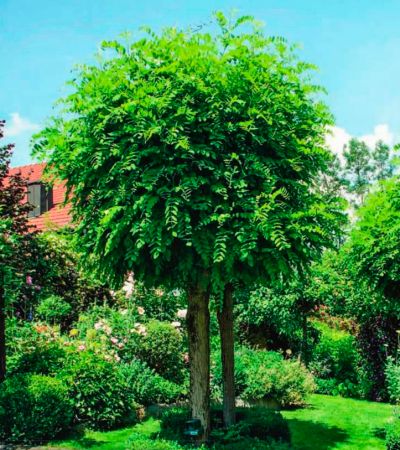

Trees with ball crowns can be roughly divided into two groups. The first includes species that tolerate pruning well, the "hairstyle" of which can be formed with garden shears. So, you can give the desired shape to boxwood, cypress, goat willow and even wisteria. Important: these plants need to be cut every year. As in the case of hedges, the shoots are shortened for the first time at the end of June, and again in the fall or early spring.
In the fall, ginkgo appears in gold attire.
The 'Mariken' plant has a small crown.
In the standard form, the tree will be appropriate even in a flower garden.
This ball remains green in winter: Lawson's cypress (Chamaecyparis lawsoniana) will retain its excellent shape if the shoots that break out of the crown are regularly cut off.
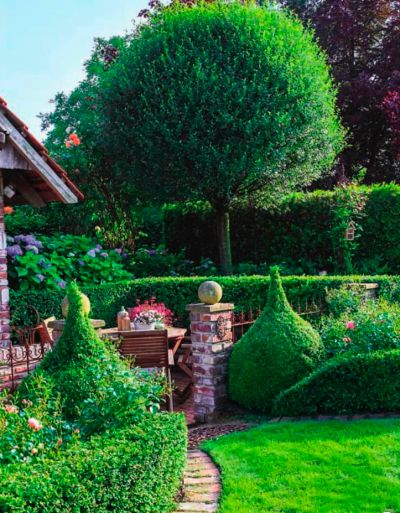

The second group includes special varietal plants in which the crown by nature has a spherical shape. These are, for example, the Globosa shrub cherry, the 'Gum Ball' liquidambar and the Mariken ginkgo biloba. Unlike traditional "relatives", they have a dwarf (often bush) shape, and they are propagated by grafting on stems of different heights. Over time, the crowns become larger in volume, but the "growth" of trees is gaining weak. Important: from time to time, these plants also need to tweak their "hairstyles", since some of them, over the years, initially have spherical crowns stretching upwards.
Trees with ball crowns are ideal for planting primarily in front gardens and small gardens, because they (especially grafted forms) remain small in size. This makes it possible to predict the appearance of the garden in many years.By the way, you can find suitable candidates even for flower beds: it can be, for example, small-leaved lilac or laurel viburnum. When choosing "little princes" in the nursery, be sure to take an interest in such characteristics as the peculiarities of flowering and autumn color of leaves.
Photinia T fraseri ‘Red Robin’ is coming into vogue. However, it can only be grown in the southern regions, since it is not hardy enough for the middle lane.
Important: with the onset of cold weather, be sure to wrap the trunks of young trees with white cloth or burlap. "Clothes" will shade the bark and prevent frost cracks on sunny frosty days.
Loch Ebbingz (Elaeagnus ebbrngei) does not shed its leaves in warm winters. The plant needs to be shaded, as its bark on sunny days can suffer from frost.
The crown of the forest beech (Fagus sylvatica) is easy to shape into a ball. The rapid growth of this handsome man upwards will help to restrain the lopper. Shrub cherry (Primus fruticosa) 'Globosa' reaches no more than 5 m in height. Even without trimming, its crown looks like a lovely ball. The goat willow (Salix sargea) grows very quickly, therefore, in order to maintain the spherical shape of the crown, you will have to make a lot of effort. The 'Mas' tree in spring, like a beautiful maiden, is hung with large yellow catkins.
Swamp Oak (Quercus palustris) Green Dwarf 'grows slowly and is unpretentious. In autumn, its leaves of fiery color are a real "charm of the eyes"
Varieties of chrysanthemums
There are several types of plants. Due to the fact that there are several varieties in growth and flowering periods, they remain so popular. Separate undersized, medium and tall chrysanthemums. The first ones reach about 20-30 cm in height, the second 30-40, and the last 60-70 cm. The most common are medium-sized plants because of their moderate flowering and the ability to plant in completely different places. But undersized, you can decorate a garden, flower beds, a loggia, rooms and any room.
Chrysanthemums Multiflora are also distinguished by the flowering period. Early flowering blooms in August, mid-blooming in September, and late blooming chrysanthemums in late September and October. With the right selection of various species, you can provide yourself with a blooming flower bed all the time from summer to the onset of cold weather.


Popular varieties
Most often, chrysanthemums are planted in open ground and care for such species as:
- "Ida" is a plant of medium height (up to 60 cm). The plant ball is dotted with small flowers, 3 cm in diameter. The color of the petals is in white-pink tones.
- "Knop" - the variety belongs to the undersized. It is distinguished by abundant flowering. Plant height is about 30 centimeters. More than 140 yellow flowers can bloom on one plant at the same time.
- The Multiflora series is a plant with small flowers of various shades. Depending on the variety, chrysanthemums bloom from August to October. There are over a hundred hybrids in this series.
Florists often plant chrysanthemums in open ground and care for them, choosing low bushes. Among the varieties, Branbeach multiflora is preferred. The series is characterized by large flowers, with a diameter of up to seven centimeters, an average height of a shrub (up to 50 cm), a small cap, with a diameter of about 40 cm. There are several shades in the series:
- orange - blooms with fiery orange flowers, a bush about half a meter in height, blooms from the beginning of September;
- lilac - a plant with lilac-pink flowers, blooms from the beginning of September;
- white - a dwarf bush with white flowers blooming at the end of August;
- yellow - medium-sized flowers, about five centimeters.
Planting chrysanthemums in open ground and caring for different varieties of the Branfountain series are practically the same. The varieties of the series delight with their flowering until mid-November. The balls are strewn with double flowers of different shades. Branfountain includes:
- yellow chrysanthemums with a pale yellow center;
- lilac - high bush;
- coral - blooms in mid-August;
- lemon - flowers about 4 cm in diameter, lemon yellow.
Care and planting of bush chrysanthemums of the Brandroyal multiflora series comes down to timely watering, removing weeds, and removing faded buds. The Brandroyal series is represented by plants of different colors: crimson, hot pink, yellow, white with a yellow center. Each variety has its own special characteristics. So, the crimson Brandroyal has bright, elongated petals, and the bright pink ones bloom with small flowers that adorn the globular bushes.
There are two shades in the Branhill series - crimson and cherry. Both species are undersized bushes, no more than 40 cm high. A characteristic feature is flowers with a diameter of 5 centimeters.
Brandove multiflora is strewn with small flowers, about 2.5 cm in diameter, the petals of the plant are white with a green tint, the center is yellow. The variety blooms profusely and for a long time - until mid-November.
Bransky plum is a perennial globular chrysanthemum with bright double plum buds. The height of the bush is about 70 cm. The crown is neat, lush.
Jacqueline Peach is the perfect variety for those who love bicolor flowers. This chrysanthemum blooms in golden-pink flowers with a yellow-lilac hue. The plant is undersized, blooms from September to November.
Branspider Spirit is an unusual variety with lemon-colored double flowers. The plant is tall, about 70 cm.
The spherical chrysanthemum is a relatively recently bred hybrid, depending on the variety, reaching a height of 18 to 75 centimeters. In a short time, this garden flower fell in love with most landscape designers, as well as many amateur gardeners. First of all, this happened due to the peculiarity of the plant to independently take a spherical shape, without requiring pruning. A special decorative effect is given to the plantings by the fact that the leaves of a flowering bush are practically invisible behind an abundant number of inflorescences - this makes it spectacular when creating flower arrangements, decorating alpine hills and decorating hedges.
Globular chrysanthemums vary in stem height. They are usually divided into:
- Stunted or dwarf - from 18 to 35 centimeters.
- Medium-sized - from 35 to 55 centimeters, for example, Knop.
- Tall - from 55 to 70 centimeters, these include the Ida variety.
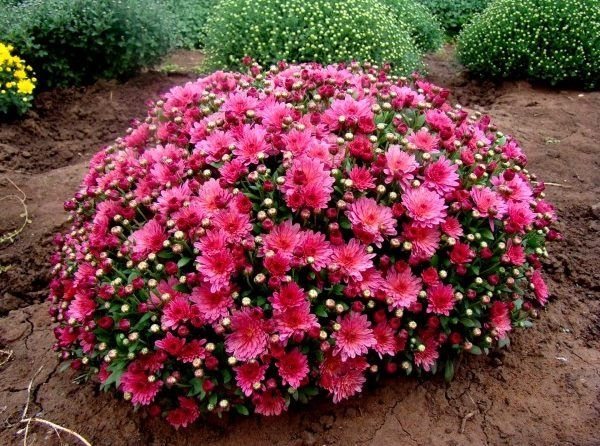

The most widespread are medium-sized varieties. They look great in a variety of garden compositions and grow well outdoors. Low-growing ones are used to decorate flower beds, are planted in pots on loggias and balconies. The tallest species are most often chosen for planting in the back row of alpine slides or flower beds.
Spherical chrysanthemums are also distinguished by the flowering period:
- Early flowering - the flowering period is in August.
- Mid-flowering - delight with bright colors in September.
- Late flowering - the inflorescences of these varieties bloom in mid-autumn.
The most common variety is Multiflora. It belongs to medium-sized and medium-flowering species, has a rich color palette.
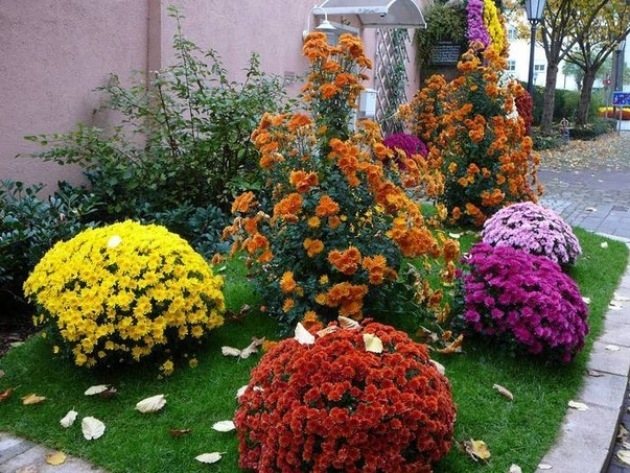

If you wish, you can choose the types of chrysanthemums for planting in the garden so that they will decorate the site from the end of summer until the first frost.
Spherical chrysanthemums are well combined in flower beds with many other flowers, they look spectacular in single plantings. Higher varieties are better combined with neighbors that achieve similar shoot growth or with conifers. Low-growing flowers in the open field are used to frame borders or beds, to create the boundaries of certain parts of the garden.
The range of various shades of color has about 3500 options. Against the background of lawn grass, white or yellow inflorescences become the most advantageous.
Planting material should be purchased directly during the planting season - in the spring.It is at this time that you can make sure of the good quality of the plants and be sure of the vitality of the flowers. At the time of purchase, you need to pay special attention to the root system of the bush - the presence of spots or signs of rot indicates a disease. The root shoots should not be dried out - this happens when flowers are not stored correctly in the winter season.
Read also Which potato is better red or white


In order for the spherical chrysanthemum to be able to easily adapt to a new place after planting, it is recommended, without ignoring the advice of specialists, to competently prepare the planting material. A few days before the planned planting of the flower in the open ground, the rhizomes of the plants should be sprayed with water and left in a warm room. This procedure is performed so that the seedlings can give their first shoots, thereby indicating the beginning of the growing season. At this time, it is important to protect them from direct sunlight and drafts.
The soil in the place chosen for growing the bushes of spherical chrysanthemums must be put in order - weeds must be removed from the territory, thoroughly loosened, and the soil abundantly moistened.
Planting is best done in cloudy or cloudy weather. If this is not possible, then early morning hours should be chosen for events.
When choosing a place to grow this type of flowers, remember that sunlight promotes abundant flowering and better bush formation. In the shade, the plant blooms later, and the shoots may have a tendency to stretch in height and thin the stems.
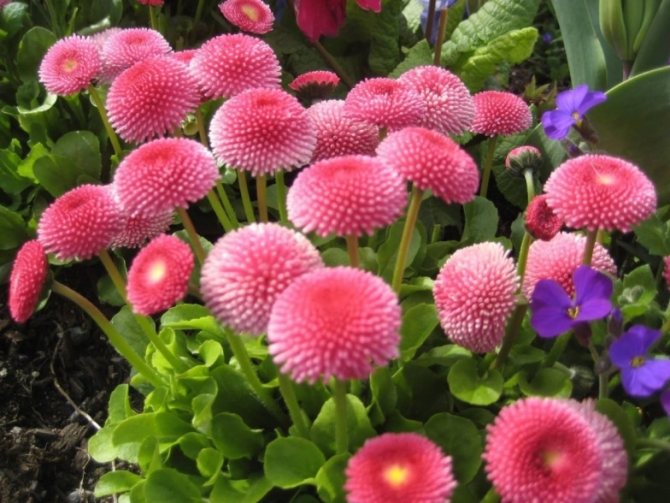

For each seedling, you need to prepare a planting hole with a depth of 45-50 centimeters and fill it with water. After all the moisture has been absorbed into the ground, a drainage layer of broken brick or crushed stone is laid out on the bottom of the pit. A five-centimeter layer of fertile soil is laid on top - garden soil mixed with compost or humus.
The seedling is placed in a hole, the roots are carefully straightened, preventing them from bending and damaging. Then the entire volume of the pit is covered with soil mixture, the planting is watered and, after the earth has settled, the required amount of soil is added.
In the first 2-3 days, it is better to shade the flowers so that the sun's rays do not burn young unrooted shoots.
Immediately after planting, the spherical chrysanthemum is pinched, removing the growth point. This will help the plant to take the shape of the correct ball, which is genetically laid for this type of flower.
Chrysanthemum spherical - the flower is not pretentious, however, like all living things, it needs care and feeding. The optimal time for fertilizing the soil of a flower garden is spring, or rather, April. During this period, the plant enters the phase of vegetative development and needs an additional source of nutrients. Mullein or humus is an excellent remedy.
The second time the flowers are fertilized at the stage of bud formation. This procedure contributes to a brighter and more luxuriant flowering of the bush. For feeding at this time, superphosphate or other phosphorus fertilizer is used.
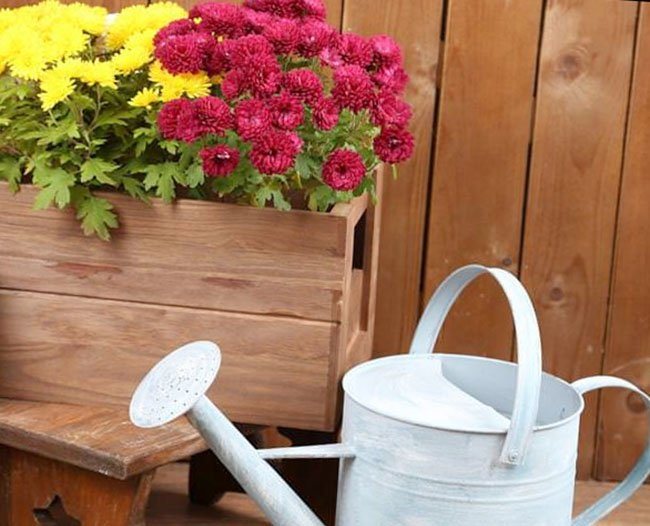

Chrysanthemum is a very moisture-loving plant, which means that the gardener needs to ensure that the ground at the site of planting these flowers does not dry out, is sufficiently moist. It is advisable to constantly maintain it in a loose state and regularly clean it from weeds, which not only takes some of the minerals from the soil, but also spoils the decorative appearance of the plantings.
Most often, chrysanthemums suffer from caterpillar attacks. These insects attack the stems and leaves of plants. To protect flowers from pests, every spring you need to spray the flower beds and flower beds with special preparations that can be purchased at any garden store.
Another common chrysanthemum ailment is powdery mildew. This disease occurs when the soil is excessively wet. The main signs of the presence of this fungus are the blackening of the leafy part of the bush and the exposure of the shoots.If you find these symptoms of the disease, you should immediately take measures to treat the plants:
- The first step is to cut off all damaged flower fragments and burn them to prevent the spread of fungal spores in the garden.
- Then you need to replace the top layer of soil at the site of growing chrysanthemums. This is where most of the powdery mildew spores are located. The removed soil should not be used on the site - it should be disposed of.
- To eliminate the fungus remaining on the plant, the plantings are sprayed from a spray bottle with soapy water with the addition of copper sulfate. A bucket of water will need 10 grams of the above-mentioned preparation and 80-120 grams of laundry soap. This amount of solution is enough for 5–8 sprays, which must be carried out at weekly intervals.
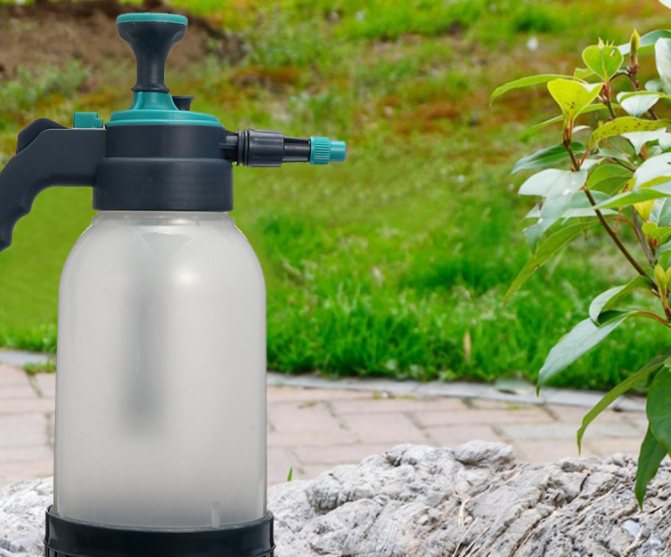

To prevent the appearance of root rot, Fitosporin is added to the water for irrigation several times per season.
The easiest way to reproduce chrysanthemums is to divide the rhizome of an adult bush. The procedure is not only a method of obtaining new plants, but also renews old plantings, which have stopped in growth and development, and, therefore, have begun to bloom worse.
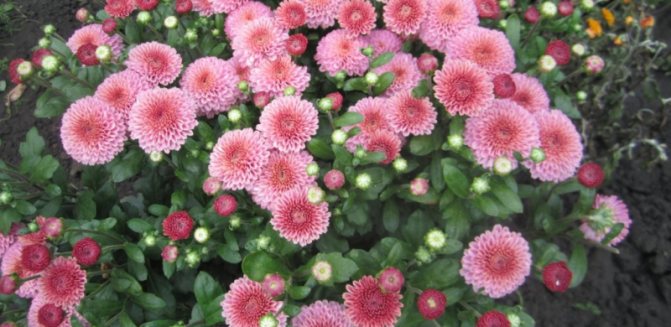

A bush that has reached the age of four usually loses its decorative effect: the flowers become smaller, there are fewer young shoots, the shape of the ball is lost. All these signs are prerequisites that the plant may die due to old age. To prevent this, in the spring you need to dig it out of the ground and cut the rhizome of the chrysanthemum into several approximately equal parts.
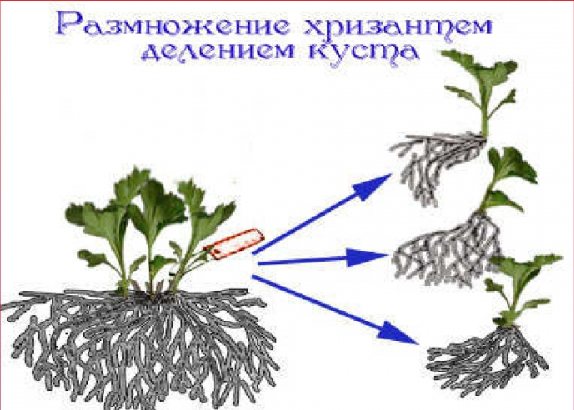

All sections must be sprinkled with ash to disinfect and quickly tighten the resulting damage. The resulting small bushes are planted in new places in the same way as seedlings after purchase.
Spherical chrysanthemums, when planted with seeds, are not able to retain the characteristics of the variety from which they were created. Therefore, this type of propagation is extremely rare and does not entail the appearance of the desired variety of flowers.
Another good technique is grafting. Strong branches are cut from the bush and placed in a container of water or wet sand until roots form. On average, it takes no more than a week. Immediately after the appearance of the first two or three root shoots, the plants can be planted on their own in new prepared places in the garden.
Spherical chrysanthemums are perennial flowers, but, unlike their counterparts, they cannot boast of frost resistance. Therefore, for the winter, they should either be dug up and stored in a cool, ventilated room, or cut and carefully insulated. When choosing the last option to save plants until next season, there are a number of steps to follow.
At the end of the flowering period, when the upper part of the plant shoots begins to dry out, the stalks of the chrysanthemums are cut off, leaving hemp above the soil surface no more than 8–12 centimeters high. Landings must be covered with a layer of dried flowers or spruce branches. This type of shelter is good because it reliably protects flowers not only from the effects of cold, but also from pests. And in the spring, natural materials will not prevent plants from releasing young shoots even before the insulation layers are removed.
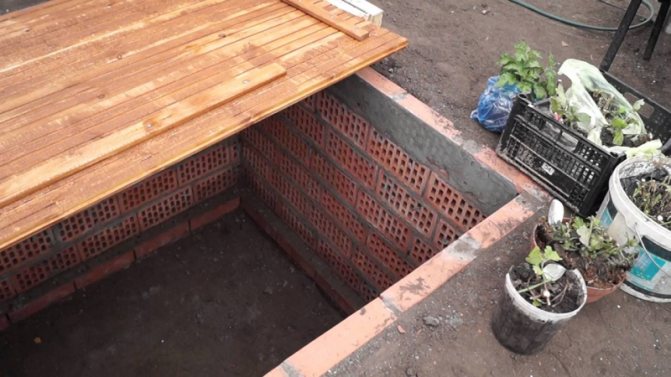

To preserve flowers in winter in regions with cold climates and severe frosts, it is better to transplant them before spring in flower pots or boxes of sand and transfer them to a balcony, cellar or basement. In mid-April, in order to awaken the bushes from vegetative dormancy, the containers are transferred to a room with room temperature and kept there until they are planted back into the flower beds and flower beds.
In general, caring for chrysanthemums is not difficult, but in order for this flower to really please the eye with its flowering, you should not forget about the elementary rules - watering, feeding and periodic rejuvenation of the bushes.
Ball-shaped chrysanthemums were bred quite recently for growing in gardens, and in a short time they managed to gain great popularity. These flowers are distinguished by exceptional decorativeness and at the same time are unpretentious in their care. The flower feels great outdoors and does not cause much trouble with planting.
We plant bush chrysanthemums ...
You have purchased neat bushes of small-flowered chrysanthemums in garden centers or from private owners, or they have already been growing in the garden for more than one year and need to be planted. You can simply divide the roots into parts and plant each one separately. The plant takes root well and you will have several bushes. Before digging up the bush, water it to saturate them with moisture.
We prepared the site in advance, divided it into grooves. The distance between the holes is small, almost close, so that between the bushes it turns out 35-40 cm, small border compact bushes can be planted denser - 20-25 cm. It is advisable to add some kind of organic fertilizer or compost to each hole. Since the roots of a young plant are still weak, mineral fertilizers are not poured into the planting hole, otherwise we risk "burning" the roots.
In early spring, 1 time in 3 years, multiple shoots should be planted. We dig out the whole mulched bush when the regrown shoots reach a height of 5-7 cm.
We take a bush, shake off the ground and begin to simply break it in half. Then we separate the neat well-developed sprouts with roots one by one. If a sprout is left without a root, then it can be rooted like a cutting in damp ground. The sprouts can be small, medium or large, depending on the parent shrub we choose to plant. Fill the holes with water and, like any seedlings, plant chrysanthemum plants.
If you plant it correctly and follow the simple rules of care, the perennial chrysanthemum flower will be able to decorate your garden for a long time.
What is the difference between the variety
The spherical chrysanthemum belongs to the Asteraceae family, it is one of the most common garden plants. The name of the spherical chrysanthemums speaks for itself - they have a round and curly head, form numerous small-flowered inflorescences. Globular flowers naturally grow during the growth process, this is due to their genetic characteristics. Another name for the plant is spherical Multiflora, another synonym for the plant is Chinese chrysanthemum. There are several varieties of spherical chrysanthemums, they vary in size, color, shape features.
These chrysanthemums are classified as perennials - after planting, they grow for a sufficient number of years. Flowers are considered decorative - they are grown in pots, flowerpots, in flower beds to decorate the interior and personal plot. Florists find tons of ideas on how to incorporate them into their original flower arrangements. Due to their shape, they do not need pruning. The flowering of spherical chrysanthemums lasts a long time - from summer to the first frost.
Classification and varieties
The classification of spherical chrysanthemums is carried out on several grounds - the shade of the petals, the shape of the inflorescence, the height of the stem, and the time of flowering.
By flowering time, ball chrysanthemums are:
- early - bloom in the first half of August;
- medium - flowering time falls in September;
- late - bloom only in October, bloom until frost.
According to the height of the stem, these chrysanthemums are divided into:
- undersized or dwarf - their height is no more than 30 cm;
- medium-sized, which stretch up to 50 cm;
- tall - with a height of more than 60 cm.
There are several varieties of spherical chrysanthemums that differ in color:
- rich lemon shade, bloom in September, the average diameter of the bushes is 50 cm;
- another type of bright yellow flowers - Sunny, bloom in August, grow up to 50 cm;
- bush chrysanthemum of deep red color 40 cm high, it is referred to as undersized;
- pink flowers are of medium height;
- lilac-purple, bloom in September, stretching up to 50 cm;
- the time for flowering orange chrysanthemums also falls in September.
Wintering features
Planting chrysanthemums in the garden and caring for them forces the plants to be prepared for wintering every year. This is necessary in order to preserve the varieties you like.
If the plant is grown in regions with mild and warm winters, where there is no frost below -7 degrees, then the bushes are covered with spruce branches or covering material for the winter. The plants are pre-pruned, leaving no more than ten centimeters of the aboveground part.
In regions with harsher winters, chrysanthemums should be dug up, planted in pots and stored in a cool room until next season. With the arrival of spring, they are transferred to their place, having previously prepared the flower bed: they apply fertilizers, renew the soil, prepare planting pits with drainage laid at the bottom.
Read also Can eggplants be pregnant
Choosing a place
A sunny place is selected for flowers, since the shade helps to stretch the shoots and poor flowering. When choosing a place, one should take into account the high sensitivity of plants to moisture. Because of this, it is worth planting bushes where there is no stagnant water, there is drainage, drainage.
Planting and caring for garden chrysanthemums boils down to planting the plant in nutrient-rich soil with good drainage. Before planting a bush, the garden bed is enriched with peat, humus, but without enthusiasm, otherwise an excess of fertilizer will negatively affect flowering.
General information about the plant
The height to which spherical chrysanthemums grow depends on the selected variety. There are undersized, medium and tall plants of this species. However, the difference between varieties is not limited to height alone. There are over a thousand species of this plant, which differ in color.
This flower has several names that reveal its properties from different angles. In addition to the name that describes the appearance, that is, "chrysanthemum ball", there is also an indication of the origin - Chinese chrysanthemum. Almost all varieties of this plant are bred in China.
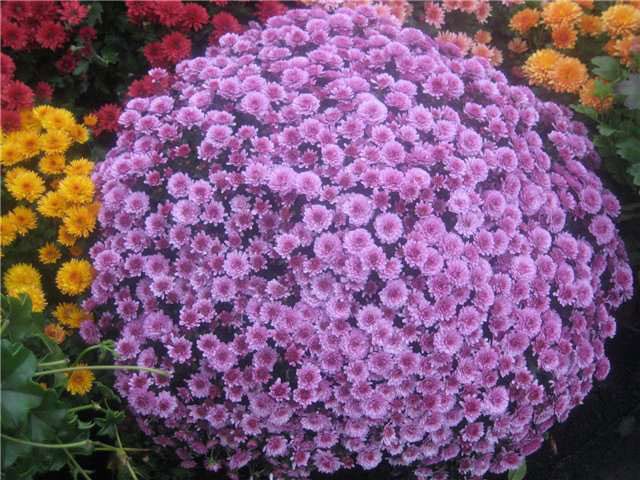

Chrysanthemum spherical
To maintain a rounded shape, this flower is grown from seedlings, since it is not always possible to get a bush of this type when propagating from seeds. Instead of a ball, the plant can simply stretch out in length.
Plant propagation
The best way to propagate spherical chrysanthemums is to reproduce by dividing the rhizomes, because they do not retain varietal characteristics when planted with seeds. A few years later, the plant has dense shoots and stops developing, which means it loses its decorative effect. This means it's time to update it. The right time for this is spring, when the bush is ready to plant. To do this, you need to divide the appeared leaves into several identical parts. Sprinkle the cut area immediately with ash so as not to get infected with the chrysanthemum.
About limited watering of the overwintered mother plant of chrysanthemum
I want to draw your attention to a common mistake with excessive watering, which many growers make when they take out multiflora mother plants from the basement in the spring, which are already beginning to germinate.
The mistake lies in the fact that overwintered chrysanthemum bushes begin to water abundantly after storage. This often leads to the death of multiflora from the clogging of the rhizome.
To prevent this from happening, you need to water the uterine chrysanthemum bushes only after the earth has completely dried out. And at the same time, do not spill the entire earthen lump, but take literally half a cup of water and splash it over the surface of the substrate in the pot.
Planting chrysanthemums
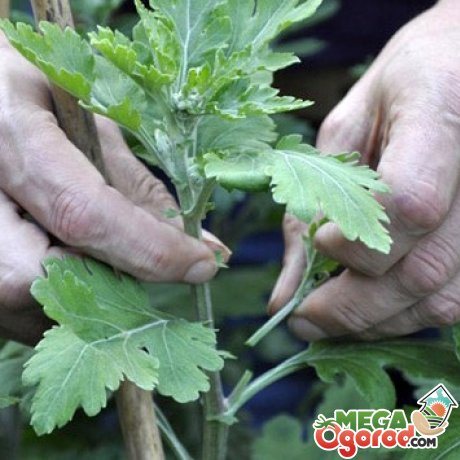

The soil for growing chrysanthemums should be loose, nutritious. The growing area is sunny. Chrysanthemum is a plant of short daylight hours. They take out the chrysanthemum from the cellar as early as possible: at the end of March or the beginning of April. Water, set in a warm place. Active growth soon appears.Divide the bush into parts, choosing all the processes that have at least one bud. They are planted separately in open ground or greenhouses.
If the bushes are not separated, then the chrysanthemum will grow only one taproot. In this case, young roots and shoots will not form. The shoots are planted in greenhouses, one stem at a time, so that roots form on the shoots. First, the green cuttings are cut to the same length, the lower leaves are cut off. They are treated with Kornevin. They are planted in a light substrate. Roots are formed in a week. You can put the cuttings in a jar of water and wait for the roots to appear on them. Bushes of the same size will grow from such cuttings.
In theory, chrysanthemum can be grown from seed. But in practice, this method is very lengthy and requires constant attention. In addition, varietal traits may not be transmitted with this propagation method. By pinching the top of the stem, you can adjust the size of the bush. If you spend it in March, the bush will be the maximum for this variety, in April - medium, in June - small.
A spherical chrysanthemum should be planted in open ground early, after the threat of severe frosts has passed.
Then it will bloom faster. Chrysanthemum tolerates light frosts well, but young unrooted plants need to be covered with a sharp drop in temperature. Saplings are planted at a distance of approximately 50 cm from each other. It depends on the variety and the estimated size of the bush. During the flowering period, they should not merge with each other. It is necessary to provide for the paths for the care of the bushes. Fertilizers specially designed for chrysanthemums, such as Kemiru, can be added to the wells.
Bushes that have wintered in the ground more than once are also planted. If this is not done, many plants will grow from one place, which will interfere with each other. A beautiful rounded bush with such cultivation will not work.
Benefits of planting chrysanthemum multiflora seedlings in pots
For those gardeners who have many different flowers growing in their flower beds, including heat-loving summer plants, the option of planting multiforum chrysanthemum seedlings in pots is very convenient.
Plant multiflora seedlings one plant at a time in large pots (3.5-5 liters) with drainage holes at the bottom. Then these pots with spherical chrysanthemum seedlings MUST BE BURNED into the ground. This will save the potted plants from adverse natural factors (from overheating in summer, from overturning by the wind, etc.).
Planting multiflora chrysanthemum seedlings in pots is convenient and rational for several reasons. Firstly, while the chrysanthemum seedlings are still small and insufficiently decorative, you can temporarily dig in pots with developing bushes, first not in the front place of flower beds, but somewhere on the sidelines or in the garden, where the young plants will be spacious and sunny. Then, closer to autumn, when the chrysanthemum multiflora already forms a beautiful spherical crown and is completely covered with buds, preparing to bloom, it is time to dig up the pots with spectacular plants and move them to a prominent place in the garden. For example, dig up flower beds in the foreground instead of fading summer beds. At the same time, such a movement of pots with chrysanthemums to a new place will be completely painless for flowering bushes.
Secondly, the advantage of planting multiflora seedlings in pots is that for a small pot volume, it is not difficult to prepare a nutritious and light substrate with the addition of perlite or vermiculite.
Thirdly, the multiflora chrysanthemum bushes growing in pots will not need to be dug out of open ground in the fall and transplanted - before lowering the plants to the basement for the winter. It will be enough just to remove from the flower beds and transfer the pots with treated chrysanthemum queen cells to the right place.
Why are these flowers so popular with gardeners?
But these flowers won the hearts of gardeners not only with their fabulous appearance:
- Unlike other varieties, they often bloom even at the end of August, delighting flower growers all autumn.
- Due to their unique genetic properties and constant selection, they do not require any pruning and shaping at all: the bush acquires a spherical shape completely independently. But some experts say that it is more useful to pinch the tops when about four pairs of leaves appear on them. However, in 90% of cases, this event is not necessary, since the spherical chrysanthemum will acquire the necessary outlines without your intervention.
- In addition to the vegetable garden and garden, the bushes of this amazing plant feel great even on the windowsill, being planted in flower pots. In a word, they are everywhere capable of becoming a real decoration of the area, attracting admiring glances to themselves.
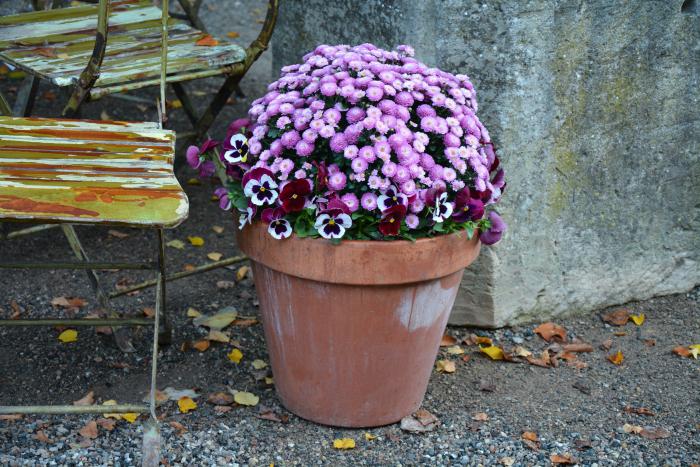

The only obstacle for beginners can be their wintering, which requires certain conditions and care.
General classification of chrysanthemums
Chrysanthemums come in many different types. They are divided by flowering time, stem type, bush height.
By the timing of flowering, plants are divided into early, middle and late varieties. The latter bloom in November, the middle ones in October, and the early ones in September.


The first varieties to bloom are:
- "Anita" - blooms with a spherical white flower. It is very large, it can reach a diameter of 20 cm.
- "Lilac Bislet" is a spherical lilac flower.
- "Blanka".
- Broadway, pearl.
- "Cremist".
- Milka.
- "Resolute".
- Shlef-Purple.
- "Kornikova".
- Regalia.
All the varieties presented above are large-flowered. They have huge flowers, reaching a size of 18-20 cm. The bushes themselves reach a height of about 90 cm. Most often, chrysanthemums are grown to create bouquets. Huge flowers are formed on the stem, up to 18 centimeters in diameter or more. The corollas of the petals are flat, tubular, thick. Depending on what kind of petals are, determine the flowering period. It usually lasts from September until the New Year. To preserve the beauty of the flowers, they are carefully removed from the soil, transplanted and harvested by the end of October.
Small-flowered varieties can have double or simple flowers, with a diameter of about 9 cm. Among the small-flowered varieties, the Santini hybrid obtained by Dutch breeders is distinguished. The variety is a plant with small flowers about 5 cm. Up to 30 or more flowers bloom on one bush at the same time. A distinctive feature of the variety is its decorativeness and compactness of the root system, which is why it is grown in a container.
In height, tall, low and medium-sized plants are distinguished. Large-flowered varieties and single small-flowered varieties belong to high ones. They are characterized by a well-developed bush, which requires strengthening with supports, large inflorescences.
Popular representatives of large-flowered varieties are the varieties "minx", "tamara", "lilac fog". They have flowers from seven to ten centimeters, in different shades.
Low-growing species occupy a special place in landscape design. They are often used as curb plants. These varieties are formed in the form of a ball, strewn with bright flowers of various colors. Popular types of low chrysanthemums are "talisman", "gels", "ausma", "multiflora".
Medium varieties are presented in a variety of colors. They can have simple and double flowers. This species has flowers about seven centimeters in diameter. Unlike curb varieties, medium-sized ones are used for cutting. Popular varieties include Umka, Mirage, Princess Diana, and Bronze Crown.


Description
To date, there are a lot of different hybrids with unusual colors. Planting a globular chrysanthemum and caring for it requires knowledge of the characteristics of the plants.
The spherical chrysanthemum is a shrub of the Astrov family.She has light green leaves, arranged alternately, with a simple shape and pronounced, clear notches. The plant is able to independently take a rounded, beautiful shape, without any additional haircut. The top of the hat is decorated with flowers that hide the foliage. They are grouped into baskets. Flowers are multi-tiered, most often double. After flowering, an achene is formed.
The care and planting of chrysanthemums in open ground depends on the type of plant, since they have external differences in flowering time, bush height, frost resistance. Spherical varieties in height can reach 80 cm. Flowering occurs in different periods - some bloom in August, and some in October.


